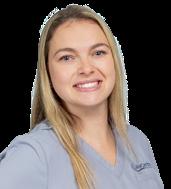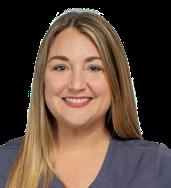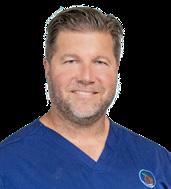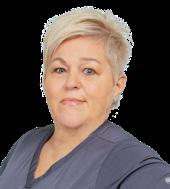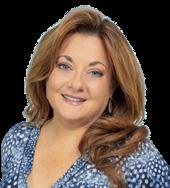












































At Village Heart & Vein Center, we hold the Key to your heart – offering unparalleled care tailored specifically for our patients. With a philosophy rooted in the power of partnership, we unite with you, your family, and your primary care physician to craft a heart-healthy future.
With Village Heart & Vein Center, experience the profound difference of a center where cutting-edge technology meets human compassion, all in the name of exceptional heart care. We are expanding, growing, and reaching out so that each heartbeat can be as vibrant as life itself.
Because your heart deserves the best, and we are here to give you just that – today, tomorrow, always.
352.674.2080

Smoking (including secondhand smoke and smokeless tobacco, sometimes called “chewing tobacco” or “snuff”) is the number one risk factor for getting head and neck cancer. And people who use both tobacco and alcohol are many times more likely to get head and neck cancer than people with neither habit. Research has also shown that continued smoking by a patient with head and neck cancer may reduce the effectiveness of treatment and increase the chance of a second primary cancer.
RBOI is a member of the Tobacco Free Florida Partnership of Marion County. We support efforts to create tobacco-free environments and smoking cessation and prevention programs, especially those targeted to our youth. Wendy Hall, a Licensed Clinical Social Worker and Cancer Navigator at RBOI, is also a tobacco cessation specialist. Call her at 352-527-0106 for more information.
Hoarseness and voice changes can be a sign of head and neck cancer; see your doctor if they do not improve within two weeks. Head and neck cancers can also start away from the vocal cords and produce other symptoms. The most common is swelling or a sore that does not heal. Other symptoms include:
• Persistent sore throat
• Constant coughing
• Pain/difficulty chewing, swallowing, or moving jaw or tongue
• Ear pain/infection
• Trouble breathing
• A lump, bump, or mass in head or neck

• A red or white patch in the mouth
• Foul mouth odor not explained by hygiene
• Persistent nasal obstruction/congestion
• Frequent nosebleeds and/or unusual discharge
• Double vision
• Numbness/weakness in the head and neck region
• Blood in saliva or phlegm
• Loosening teeth
• Dentures no longer fit
• Unexplained weight loss
• Fatigue
by the numbers
Head and neck cancers are divided into five main types:
54,540
New diagnoses of oral cavity and pharynx cancers in the US estimated for 2023.
1%
Average annual rate of increase in new oral cavity and pharynx cancer cases over 2010–2019.
Human papillomavirus (HPV), the most common sexually transmitted virus in the US, has been playing an increasing role in head and neck cancers, especially oropharyngeal cancers. According to the Centers for Disease Control and Prevention (CDC), HPV is thought to cause 70% of oropharyngeal cancers in the US.
The CDC recommends HPV vaccination for 11- to 12-year-olds, and for everyone through age 26 who has not been vaccinated. Adults age 27 through 45 are encouraged to speak with their doctor about their risk of HPV infection and the possible benefits of vaccination.
More than 2x
Head and neck cancers are more than twice as com mon among men as they are among women.
• Laryngeal and hypopharyngeal cancers occur in and around the voice box.
• Nasal cavity and paranasal sinus cancers occur behind the nose.
• Nasopharyngeal cancers occur at the upper part of the throat behind the nose.
• Oral and oropharyngeal cancers occur in the mouth, tongue, and the area from tonsils to voice box.
• Salivary gland cancers occur in the mouth glands that produce saliva.
A specific head and neck cancer, nasopharyngeal carcinoma (NPC), now has a new treatment option. The Food and Drug Administration recently approved toripalimab (Loqtorzi), the first immunotherapy drug used to treat this kind of cancer.
4%
Percent of all cancers in the US that are head and neck cancers.
Patient-centered radiation oncology close to home
The Villages 352.259.2200
Ocala 352.732.0277
Timber Ridge 352.861.2400
Inverness 352.726.3400
Lecanto 352.527.0106
RBOI.com
NPC occurs behind the nose, which can complicate surgery. And there is no standard treatment if NPC has spread after chemotherapy. But clinical trials showed that toripalimab shrank tumors and extended survival. Like us







25

57

65


71
finance mind body
26
Eat Fit Not Fat
Discover guilt-free indulgence with this protein-packed twist on a beloved classic: Doughnuts!
Recipes: Louis Santiago
30
Strength and mobility
Personal trainer Caleb Miller demonstrates exercises that target upper- and mid-back muscles.
58
Keeping intimacy alive
Goodbye inhibitions, hello passion.
Story: Sabrina Ciceri
60
Provider-Patient connection
Dad and daughter debate the gender of physicians and how choosing a
66
Shadows of the past
Dive into the tangled web of attachment styles, where past traumas intertwine with present relationships. Uncover the keys to understanding and navigating love’s complex terrain.
Story: Cynthia McFarland

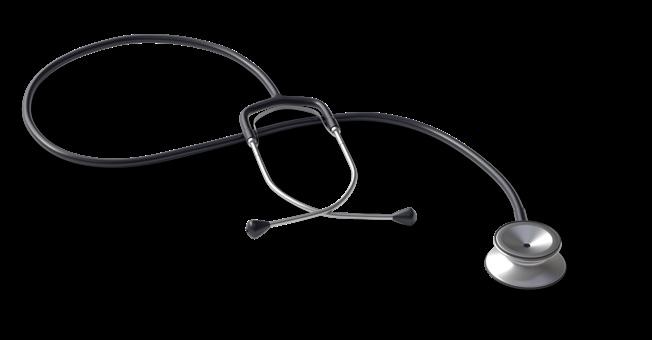
72
The lighter side of numbers
Embark on a laugh-outloud journey into the realm of ‘Girl Math’ and get ready for a math lesson like no other.
Story: Healthy Living Sta
74
Eating well, saving big
Explore savvy and savory tips on how to nourish your body and wallet simultaneously.
Story: Healthy Living Sta
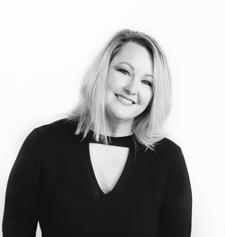
Discussing women’s health can often feel like embarking on a journey through a complex labyrinth of information and choices. But do not fear, Healthy Living magazine is here to help start the conversation. We are dedicated to being your trusted companion through this exploration. In this issue, we are providing insightful guidance and fostering meaningful discussions on the topic.
We delve into the nuanced and essential realm of sexual health, shedding light on lesser known, yet critical aspects. We challenge taboos, debunk stereotypes and promote candid conversations. Together, let’s dispel myths and embrace empowerment in a community of support and understanding.
You will also learn about the silent epidemic of heart disease a ecting women. Explore how to identify warning signs, comprehend risk factors and advocate confidently for your heart health in an empowering manner.
When it comes to selecting healthcare providers, the choice is deeply personal. In our exclusive advertorial section, you’ll discover a curated selection of exceptional female healthcare professionals who not only o er medical expertise but also understand and respect your unique experiences.
Our mission is to inspire, educate, provoke thought and navigate the diverse landscape of women’s health together. The future of women’s wellbeing shines brightly, driven by the strength of communities, advancements in medical science and the power of individual stories like yours.
We invite you to join the conversation on social media. Share your thoughts, experiences and insights on women’s health.
Use our hashtag #HealthyLivingCFForHer to connect with others and contribute to a larger dialogue about empowerment, well-being and breaking down barriers. Your voice is crucial in fostering a supportive and informed community.
Join us on this important journey and let’s make a di erence together.
In closing, allow me to share a cherished scripture that resonates with our belief in the beauty of every individual: “I will praise You, for I am fearfully and wonderfully made; marvelous are Your works, and that my soul knows very well.”
– Psalms 139:14

Kendra Akers OWNER/PUBLISHER kendra@akersmediagroup.com
Doug Akers PRESIDENT doug@akersmediagroup.com
DESIGN | PHOTOGRAPHY | EDITORIAL
Michael Gaulin CREATIVE DIRECTOR michael@akersmediagroup.com
Shawnee Coppola DESIGNER shawnee@akersmediagroup.com
Alejandra D’Jermanos DESIGNER alejandra@akersmediagroup.com
Brittany Fogt DESIGNER brittany@akersmediagroup.com
Roxanne Brown MANAGING EDITOR roxanne@akersmediagroup.com
Gina Horan STAFF WRITER gina@akersmediagroup.com
Christine Andola STAFF WRITER christine@akersmediagroup.com
Nicole Hamel CHIEF PHOTOGRAPHER nicole@akersmediagroup.com
DIGITAL MEDIA
Cindy Peterson DIGITAL MEDIA EDITOR & PHOTOGRAPHER cindy@akersmediagroup.com
Kyle Coppola DIGITAL MEDIA SPECIALIST & SPORTS WRITER kyle@akersmediagroup.com
CONTRIBUTING WRITERS
Cynthia McFarland
Karon Warren
Sabrina Ciceri
Marc Robertz Schwartz Cadi Schwartz
Louis Santiago
CONTRIBUTING EDITORS
Gary Corsair Katie Sartoris
SALES
Tim McRae VICE PRESIDENT, SALES tim@akersmediagroup.com
Jennifer Poole
jennifer@akersmediagroup.com
Melanie Melvin ADVERTISING REPRESENTATIVE melanie@akersmediagroup.com
Shaena Long ADVERTISING COORDINATOR shaena@akersmediagroup.com
Emily Gaulin
emily@akersmediagroup.com
Aubrey
aubrey@akersmediagroup.com









International Moment of Laughter Day will be celebrated Sunday, April 14. The event was created by humorologist Izzy Gesell to encourage people to laugh, gu aw, chuckle, and giggle because, medically speaking, it's good for you.
A link between laughter and healthy function of blood vessels was first reported in 2005 by researchers at the University of Maryland Medical Center. They found that laughter increases blood flow, strengthens the immune system, boosts mood, diminishes pain and protects you from the damaging e ects of stress.

The Villages was named the No. 1 place to live for pickleball by Masters Athlete Magazine. The sport is wildly popular with seniors because it o ers a fast-paced physical and mental challenge with minimal injuries.
The Villages has several pickleball clubs with certified instructors.
For rules and information, go to usapickleball.org or thevillages.com.





Being in recovery from alcohol and drug dependence can be daunting, but many celebrities have been a source of inspiration, helping struggling addicts cope. In particular, several female celebrities in recovery have been known to lend their influence on awareness of sober women’s programs and addiction treatment. Here are just a few who have opened up about their addictions and hope to inspire others to get sober.
• Oprah Winfrey
• Drew Barrymore
• Jamie Lee Curtis
• Angeline Jolie
• Jada Pinkett Smith
• Mary J. Blige
• Jane Lynch
• Kristen Davis
• Eva Mendes
• Miley Cyrus
• Gisele Bundchen
• Adele
• Chrissy Teigen
Fermented foods have been a part of the human diet for almost 10,000 years and can bolster the gut microbiome, creating a healthier mix of microbes and strengthening the walls of your intestines. Once ingested, nutrients and microorganisms from fermented foods can survive to interact with the gut and are considered an important element of the human diet.
INCLUDE:
• Kimchi
• Sauerkraut
• Miso
• Pickled vegetables
• Apple cider vinegar
Pickled foods can be found locally at Brown’s Country Store, 13940 US 301, Oxford.
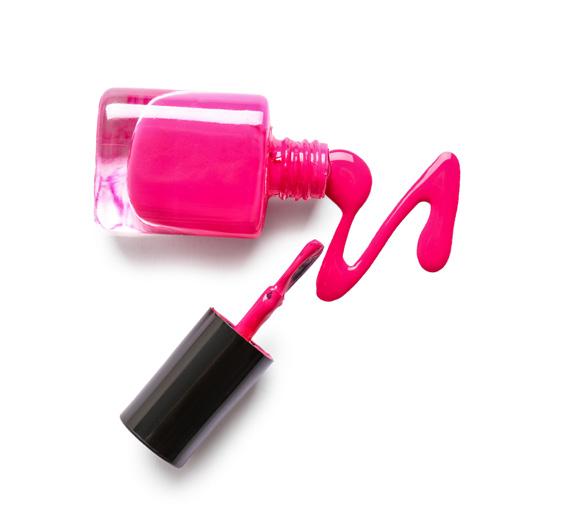
Having manicured nails is more popular than ever, but before you entrust your mani to just anyone, make sure you research the salon or get a solid recommendation. The four most popular types of nail treatments are:
Benefit: Easy to apply and dry.
Disadvantage: It doesn’t last long.
Benefit: Very strong and easier to remove than acrylic.
Disadvantage: May weaken nails over time.

GEL
Benefit: Protects without damage.
Disadvantage: Left uncured, the gel polish can be absorbed by the nail bed, which can be toxic.
Benefit: Very strong and long-lasting.
Disadvantage: Can be di cult to remove.
Mountain biking can be physically demanding so it’s critical to choose trails that match your experience level. Santos Trail provides options for every skill level, so it won’t be hard to find one that works for you. Santos Trailhead is open from 8am until sunset, 365 days a year. There is no admission fee for day use. Camping in the developed campground is $22 a night plus a reservation fee of $6.70. For RV camping, there is also a nightly utility fee of $7, which includes water, electric and sewer. Located at 3080 SE 80th St., Ocala. For more information call 352.369.2693.
Tea, the most consumed beverage worldwide, has incredible health benefits. Both green and black tea contain high levels of antioxidants that when brewed can help prevent cell damage. The tea with the highest level of antioxidants is hibiscus.
Heart Health Green Tea


Gut Health
Ginger Tea
Lung Health
Herbal Tea
Sore Stomach
Peppermint Tea
Insomnia
Chamomile Tea
Overall Health
Black Or White Tea
You can choose from wide varieties of teas at Erika’s Tea Room, located at 787 W. Montrose St., Clermont or at The Spice & Tea Exchange of Mount Dora, located at 431 N. Donnelly St., Mount Dora. For more information about Erika’s Tea Room call 908.670.2305 or visit www.erikastearoom.com. For more information about The Spice & Tea Exchange call 352.729.6762 or visit www.spiceandtea.com.
SOURCE: CLEVELAND CLINIC
As we get older, we become less flexible, which impacts our ability to move comfortably and without pain. Many of us come to terms with debilitating conditions, like arthritis and rheumatoid low back pain by taking medication or ignoring the problem, but there’s another avenue you should consider.
CONSIDER VISITING A STRETCH FACILITY TO RECEIVE THESE BENEFITS:
• Correct compensational shifts and muscle imbalances
• Increase and maintain range of motion
• Enhance physical and athletic skills
• Relieve sti ness and soreness
• Improve sleep patterns
• Reduce stress
LOCAL PROFESSIONAL STRETCH FACILITIES:
STRETCH ZONE: WILDWOOD, LADY LAKE, OCALA
STRETCH LAB: WILDWOOD, CLERMONT

Knowing everything there is to know about your body can be a woman’s lifelong quest. For now, consider just one aspect of your physiology – your breasts. Throughout your lifetime, your breasts will be an intimate part of your development, your identity and your capacity to nurture and

comfort. Yet, you may not feel comfortable in your knowledge of breast health.

We talked to breast health expert Dr. Chand Rohatgi, a breast surgeon with UF Health Medical Group Surgical Specialists in The Villages, about some breast health myths. Here’s what he told us.
Nipple discharge and breast pain are signs of serious illness.
Dr. Rohatgi: Nipple discharge and breast pain can both be uncomfortable and alarming, but in the far majority of cases, neither one is associated with breast cancer. Several benign conditions, from infection to injury, can cause nipple discharge. If the discharge is clear or bloody, or associated with a lump, you should see your doctor just to be sure. In most cases, breast pain will respond to at-home remedies, such as over-the-counter pain relief creams like those marketed for arthritis or muscle pain. You could also try vitamin E or evening primrose oil supplements. If the pain persists or is accompanied by other symptoms, you should see your doctor.
Wearing a bra is necessary for good breast health, but underwire bras can cause breast cancer.
Dr. Rohatgi: For the most part, a bra is a fashion accessory with no medical value at all. Wearing an underwire bra may become painful, but they have never been causally linked to breast cancer. If you have heavy breasts, a support bra with wide, padded shoulder straps and a wider band at the bottom can help relieve neck and back pain. If this doesn’t work, you may be a candidate for breast reduction surgery to relieve your pain and protect your spine health.
MYTH:
There is no point in being tested for breast cancer because I could never afford cancer treatment.
Dr. Rohatgi: Actually, it’s fiscally responsible to get your regular breast cancer screenings. Screening mammograms are free through Medicaid, Medicare and all insurance companies. If you have breast cancer, early detection will give you the best possible outcome and most likely require the least amount of treatment, keeping the cost down.
MYTH:
Having a mastectomy would change who I am as a woman.

AMERICAN CANCER SOCIETY MAMMOGRAM GUIDELINES FOR WOMEN OF AVERAGE RISK OF BREAST CANCER:
AGE
EVERY YEAR
Dr. Rohatgi: If you have breast cancer, a mastectomy may not always be needed. In most cases, the preferred treatment is a lumpectomy, which removes the cancer and conserves as much healthy breast tissue as possible. According to recent evidence, conserving breast tissue may lead to better outcomes. There is certainly a psychological element to any type of breast surgery that cannot be ignored. Most women, however, lead normal, healthy lives even after a mastectomy.

MYTH:
Breastfeeding puts me at greater risk for breast cancer.
Dr. Rohatgi: One important risk factor for breast cancer is cycling estrogen. Your body cycles estrogen during the years when you are menstruating. While you are pregnant or breastfeeding, the cycling stops. The more cycling estrogen your body was exposed to, the greater your risk of breast cancer. Breastfeeding reduces your exposure to cycling estrogen, actually reducing your risk for breast cancer. Your exposure to estrogen is a risk factor you cannot change. I encourage you to focus on the risks you can change.
DO YOU HAVE A GREAT ARTICLE IDEA? ROXANNE@AKERSMEDIAGROUP.COM
EVERY OTHER YEAR
INCREASED RISK FACTORS:
Personal history of breast cancer
Family history of breast cancer
Genetic mutation
(such as BRCA)
Chest radiation before age 30
CONSULT YOUR DOCTOR FOR RECOMMENDATIONS.
We’re all ears! Share your thoughts by emailing our managing editor, Roxanne@akersmediagroup.com. Let’s create something amazing together!

Are you bothered by bright circles around lights, or glares that a ect your vision? In many cases this is perfectly normal and nothing to be concerned about.
Glare is light that enters your eye and impedes your vision, like when a camera flash goes o .
Seeing bright circles or rings around a light source, like headlights, are known as halos. Halos around lights are most noticeable at night or when you’re in dim or dark areas.
Halos As we navigate through the landscape of vision correction surgeries, it’s essential to understand that not all procedures are suitable for every stage of life. While LASIK has become synonymous with clear, glasses-free vision for many, it’s crucial to recognize that age plays a significant role in determining candidacy.
LASIK, or Laser-Assisted In Situ Keratomileusis, is a widely performed refractive surgery designed to correct common vision problems such as nearsightedness, farsightedness, and astigmatism. However, ideal candidates for LASIK typically fall within a specific age range, primarily due to the stability of their vision.
In general, individuals aged 18

and above are considered potential candidates for LASIK, provided they meet certain criteria such as stable vision prescription and overall eye health. This age range coincides with the period when most individuals’ vision stabilizes, minimizing the risk of regression post-surgery.
However, as individuals progress through di erent stages of life, their ocular health and vision needs may evolve. Patients often express interest in LASIK but may discover that their age places them outside the ideal candidacy range. Here’s a breakdown of age-related considerations and alternative surgeries that may be more suitable:
YOUNG ADULTS (18-45):
LASIK is a viable option for many young adults who have stable vision. However, it’s essential to ensure that their prescription has stabilized before proceeding with surgery.
MIDDLE-AGED ADULTS (45-60): While LASIK remains an option for some within this age group, presbyopia—a natural age-related decline in near vision—may start to become a concern.
Alternative: Refractive lens exchange (RLE) can address both
refractive errors and presbyopia by replacing the eye’s natural lens with a multifocal or accommodating IOL. This option can provide clear vision at multiple distances, reducing dependence on glasses or contact lenses.
OLDER ADULTS (60 AND ABOVE):
LASIK likely will not be suitable for most individuals in this age group due to increased risk factors such as cataracts or other age-related eye conditions.
Alternative: Cataract surgery presents an opportunity to not only remove cataracts but also correct refractive errors simultaneously. Advanced intraocular lenses (IOL), including multifocal or toric lenses, can address both cataracts and refractive issues, o ering improved vision without the need for glasses.
If you’re considering vision correction surgery or have questions about your eligibility, we encourage you to schedule a consultation to learn more about your options. Remember, age may influence candidacy for certain procedures, but there’s a solution available for almost every vision challenge.






Orlando Health South Lake Hospital Center for Women and Babies, now part of the Orlando Health Women’s Institute, provides an all-encompassing approach to caring exclusively for women’s health. From obstetrics, gynecology and urogynecology to labor and delivery, maternal-fetal medicine, oncology and breast care, we provide women’sonly care for every stage of life. Learn more at SouthLakeHospital.com/Women

As experts in home care, Visiting Nurse Association of Florida strives to make you and your loved one feel comfortable and safe. We take pride in pairing our patients with the best clinicians to meet their unique needs and personalities.
Skilled nursing
Physical, occupational and speech therapies
Wound care
IV therapy
Medication management
Meal planning/preparation
Light cleaning
Errands and laundry
Bathing,
Hourly nursing visits
Post-surgical care
Home health aides
Alzheimer’s care







you that you can have that donut and not lose any sleep at all?
Enter a healthy protein donut, a great idea for those who love to indulge and aren’t afraid to tap into those creative juices to swap some ingredients. Let’s dive in.
When it comes to ingredients, you have options. We can nix the less-than-healthy ingredients and replace them with wholesome ingredients to decrease calories and increase nutritional value without cheating on textures and flavors.
and creamy and adds moisture to the donut.
Greek yogurt: This is a great source of protein that helps add moisture and a bit of tanginess to help with the counterbalance of multiple flavors in the batter.
another popular glutenfree option and low-carb alternative. It adds moist texture and flavor to most recipes. It is also a source of protein.
Fats: You can use healthier fats. In this recipe, I use peanut butter, which is necessary to create the moisture, tenderness and richness. It also helps as a binder for the dry ingredients.
Sugars: Agave is good in moderation as a sweetener, but also has a lower glycemic index
compared to some sugars and helps control blood sugar spikes in the body. Honey also has a lower glycemic index, and it contains small amounts of vitamins and minerals. Mashed banana is a great swap in baking because it adds moisture as well as flavor. It is also a great source of fiber, vitamins and minerals.
Vanilla extract or flavoring: Vanilla is an aromatic commonly used in baked goods that enhances the way food tastes. Be careful, however, as a little goes a long way.
Oat Flour: This is a gluten-free alternative to wheat flour. It contains fiber and nutrients that are present in whole oats. It also imparts a mild nutty, slightly sweet flavor and works great
Protein powder: Whey protein is a powder derived from milk during the cheese making process. It also contains essential amino acids to help with muscle building and recovery. In baking, it adds a slight sweetness as well. Vanilla flavored is best or a neutral one.
Cinnamon: Cinnamon is great for helping regulate blood sugar levels. It also has an umami flavor profile that helps meld other flavors together to create a harmonious flavor palate in your mouth.

oat flour (65 grams)
½ cup
½ cup
½ cup
1 tsp.
½ tsp.
½ tsp.
1 Tbsp.
3 tsp.
3 tsp.
1 ½ cup
¼ cup
¾ cup
1 tsp.
vanilla protein powder (40 grams)
almond flour (55 grams)
baking powder (4 grams)
cinnamon (2 grams)
pink sea salt (4 grams)

minutes until fragrant and golden brown)
1 tsp.
2 Tbsp.
1 Tbsp.
1 tsp.
½ tsp.
Greek protein yogurt (15 grams)
honey (15 grams)
agave (15 grams)
egg (45 grams)
peanut butter (60 grams)
almond milk (60 grams)
mashed banana (2 medium) (175 grams)
vanilla flavor (5 grams)
Blend all wet ingredients in a small blender until thoroughly mixed so that all ingredients are evenly distributed. Fold the wet mixture into the dry mix. Let the batter rest for 15 minutes. Preheat your donut maker to the manufacturer’s recommend temperature (the donut maker I use can be found on Amazon, https://a.co/d/0irFjdl). I set dial to 175 degrees and spray lightly with a neutral high smoke point oil like canola or vegetable oil. Set the timer for 2.5 minutes and remove when golden. For best results, serve and eat the donuts while still warm.
1 Tbsp.
1 tsp.
1 Tbsp.
½ tsp.
1 Tbsp.
1 tsp.
Dutch cocoa powder (15 grams)
instant espresso powder (2 grams)
maple syrup (20 grams)
vanilla extract (2 grams)
agave (20 grams)
coconut water (5 grams)
salt (optional)
Mix all ingredients using a small handheld blender, then transfer the mixture into a container and store it in the refrigerator for up to a week.
LOUIS SANTIAGO
water (5 grams)
maple syrup (40 grams)
honey (20 grams)
heavy cream powder or vanilla
vanilla flavor or extract (2 grams)
Pinch of salt (optional)
co ee creamer (2 grams)

Place all ingredients into a mini blender and puree until there are no lumps. Transfer the mixture to a sealed container and refrigerate for 7 to 10 days.
½ cup
2 Tbsp.
¼ cup
frozen strawberries (60 grams)
maple syrup (40 grams)
coconut water (60 grams)
Blend with a small handheld blender on high speed until smooth. You can adjust the thickness and make thinner by adding more coconut water. Store in a sealed container for up to five days.
¼ cup
½ tsp.
1 tsp. HEALTHY PROTEIN DONUT
heavy cream (62 grams)
vanilla flavoring (2 grams)
vanilla protein powder (5 grams)
Load the ingredients into your favorite whipped cream dispenser. Follow the manufacturer’s directions on how to use it. Once loaded, put the sealed top back on and shake until homogeneous, without any visible separation or clumps. Then, add the nitrogen canister for your dispenser and shake 8 to 10 more times. It should be ready to discharge.
EDITORIAL@AKERSMEDIAGROUP.COM
Louis Santiago is the chef and owner of Chef’s Concept Kitchen, located at Ageless Beauty Med Spa in Leesburg. He has been in the culinary field since 1997 and in the community since 2000. He worked for the Morse family of The Villages®, opening numerous country clubs for them, most notably Cane Garden Country Club, where he was chef for more than 14 years.

by creating AWARENESS that lead to GENEROSITY

PROJECT LEGACY is passionate about discovering and supporting the ongoing needs of children and youth, making a positive impact in our community.
PROJECT LEGACY relies on financial support and other resources by partnering with local businesses and individuals in the tri-county area in providing participation scholarships for local youth sports and activities or fulfilling essential needs and supplies.





“As a dedicated nutritional medicine expert and a consumer myself, I deeply understand the importance of choosing high-quality supplements for optimal health. My commitment to guiding my patients toward informed health decisions leads me to confidently recommend Red Nutritionals. Their exceptional quality stands out, ensuring that users receive the best support for their wellness journey. Trust in Red Nutritionals for unparalleled quality and effectiveness in nutritional supplements.”
- Lori Esarey MS, APRN-C, FAARFM, ABAAHP OWNER AND FOUNDER OF TOTAL NUTRITION AND THERAPEUTICSSTACK & SAVE WITH CODE:
FIRSTORDER

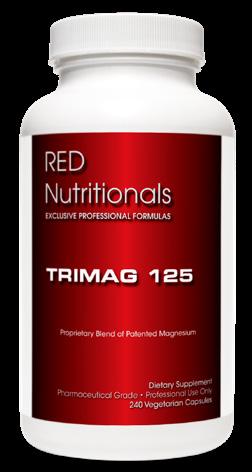


HORMONE BALANCE BUNDLE ON SALE: $140!


Hormones are the chemical messengers that regulate numerous bodily functions, from metabolism and growth to mood and reproduction. When these hormones are in balance, the body functions optimally, promoting overall health and well-being. However, various factors such as stress, diet, lifestyle, and environmental toxins can disrupt hormone levels, leading to a wide range of health issues. Balancing hormones is crucial for maintaining good health and preventing hormonal imbalances, which can manifest as symptoms like fatigue, weight gain, mood swings, and reproductive problems.
by
Caleb Miller stands as a testament to passion and dedication in the world of fitness.
Caleb’s journey began two years ago when he secured his first gym membership.
“I got my first gym membership mainly just to get into it with friends, and I ended up being the only one who stuck to it,” Caleb recalls.
The 20-year-old personal trainer relocated to The Villages from Pennsylvania last April. Here, Caleb found inspiration in his girlfriend, Abbie (also a personal trainer) and his grandparents.
Today, Caleb is a personal trainer for people in their homes and at the Iron Village Gym in Oxford. He specializes in exercise therapy and focuses on weightlifting and mobility, particularly for individuals with chronic pain.
“I do exercise therapy, which comes after physical therapy. It’s not necessarily all the little drills they do; it’s more about weightlifting and unlocking motion again,” Caleb explains.
The highlight of his career was helping a client su ering from severe tendonitis who was on the brink of surgery. Through Caleb’s exercise therapy, the client not only avoided surgery but also reclaimed the ability to golf without pain.
“Helping older people regain their mobility has been the most rewarding part of doing this,” Caleb says.

In the gym, Caleb caters to a diverse clientele, with a focus on younger individuals or those just starting an exercise regimen. He also provides at-home exercise therapy for older people who can’t leave their homes by way of his business, CCM Fitness, LLC. In the home, he uses minimal but very e ective equipment like exercise bands and adjustable dumbbells.
Caleb’s innovative approach ensures that everyone, regardless of age or fitness level, can benefit from his expertise.
“I had so many people reach out for training that just weren’t comfortable or weren’t able to train at a gym, so I wanted to bring it to people who needed it,” he says.
Caleb stands out not only for his dedication to training but
also for his continuous pursuit of knowledge. With six certifications under his belt and plans to obtain two more, he aims to provide a one-stop solution for clients that covers training, nutrition, and strength and conditioning.
“I wanted to be able to cover everything because it all really does go together. You can’t have one thing without the other,” he says.
Caleb does full body training, but for this issue of Healthy Living, he provides detailed instructions for two specific exercise machines that primarily target the upper and mid-back muscles, as well as the lats, traps, biceps and rear deltoids.
Caleb says strengthening those areas improves stability and mobility of your shoulders.
SETS: 3-4 TOTAL | REPS: 8-12 PER SET | REST: 90 SECONDS


1.
ADJUST THE SEAT ACCORDING TO YOUR HEIGHT AND SET THE WEIGHTS, STARTING WITH 10-20 LBS. AND MOVING UP GRADUALLY.
2.
PLACE YOUR CHEST ON THE MACHINE, ENSURING THE BARS FALL JUST UNDER YOUR SHOULDERS.
3.
TIGHTEN YOUR CORE TO PREVENT THE PAD FROM PRESSING INTO YOU.
4.
GRAB THE BARS, LIFT THE WEIGHT, AND FULLY STRETCH YOUR BACK.
5.
PULL THE BARS UP UNTIL YOUR ELBOWS ARE SLIGHTLY TUCKED BEHIND YOU.
6. HOLD FOR A BRIEF SECOND, THEN CONTROL THE DESCENT.
SETS: 3-4 TOTAL | REPS:8-12 PER SET | REST: 90 SECONDS


ROXANNE BROWN ROXANNE@AKERSMEDIAGROUP.COM
1.
ADJUST THE SEAT TO YOUR HEIGHT AND SET THE WEIGHT, STARTING WITH NO WEIGHT AND MOVING UP GRADUALLY.
2. SIT WITH BOTH FEET FLAT ON THE FOOT PADS.
3. BEGIN WITH NO WEIGHT AND ADJUST AS NEEDED.
4.
GRAB THE VERTICAL HANDLE WITH ONE HAND AND PULL UNTIL YOUR BICEP IS PARALLEL TO YOUR TORSO.
5. HOLD BRIEFLY, THEN CONTROL THE DESCENT UNTIL YOUR ARM IS FULLY EXTENDED.
6. REPEAT THE PROCESS FOR THE OTHER SIDE.
Roxanne Brown is an award-winning journalist with 20 years of experience in the industry. She joined Akers Media as a Sta Writer and Copy Editor in July 2020 after 16 years as a local newspaper reporter. Roxanne lives in Clermont with her family, and outside of work, enjoys reading, sunsets, music, history, and Zumba.


















Hormones are the body’s chemical messengers, orchestrating a symphony of processes crucial for overall health and well-being. From regulating metabolism and mood to supporting reproductive function and growth, hormones play a fundamental role in virtually every aspect of human physiology.
Achieving and maintaining hormonal balance is essential for optimal health, as imbalances can lead to a host of health issues and disrupt the body’s delicate equilibrium.
One of the primary reasons hormone balance is so critical is its influence on metabolism. Hormones like insulin, thyroid hormones, and cortisol regulate energy production, storage, and expenditure. When these hormones are out of balance, it can lead to metabolic disorders such as obesity, insulin resistance, and thyroid dysfunction. By maintaining hormonal balance through healthy lifestyle habits, individuals can support a healthy metabolism and reduce their risk of metabolic diseases.
Furthermore, hormones play a vital role in regulating mood and emotional well-being. Neurotransmitters such as serotonin
It’s essential to consult with a healthcare professional before starting any supplementnew
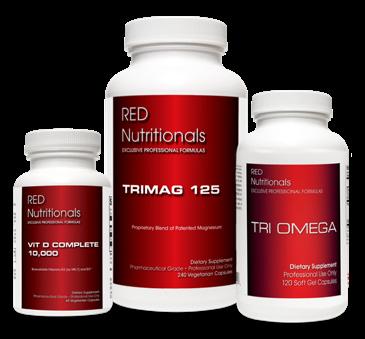
and dopamine, which are influenced by hormonal fluctuations, play a significant role in mood regulation. Imbalances in hormones like cortisol, estrogen, and testosterone can lead to mood disorders such as anxiety and depression. By promoting hormone balance through stress management techniques, adequate sleep, and a healthy diet, individuals can support mental and emotional well-being.
Balanced hormones are also crucial for reproductive health and fertility. Hormones such as estrogen, progesterone, and testosterone regulate the menstrual cycle, ovulation, and sperm production. Imbalances in these hormones can lead to menstrual irregularities, infertility, and reproductive disorders. By optimizing hormone levels through lifestyle modifications and, if necessary, medical interventions, individuals can improve their chances of conceiving and maintaining a healthy pregnancy.
In addition to metabolism, mood, and reproductive health, balanced hormones are essential for maintaining bone density, muscle mass, and cardiovascular health. Hormones like estrogen and testosterone play a crucial role in bone remodeling and
muscle growth, while others, such as insulin and cortisol, influence cardiovascular function and blood pressure regulation. Imbalances in these hormones can increase the risk of osteoporosis, sarcopenia, and cardiovascular disease.
Achieving and maintaining hormonal balance requires a holistic approach that addresses various lifestyle factors, including diet, exercise, stress management, and sleep hygiene. A diet rich in whole foods, regular physical activity, adequate sleep, and stress-reducing practices such as meditation and yoga can help support hormone balance and promote overall health and vitality.
In conclusion, balanced hormones are essential for optimal health and well-being. By prioritizing lifestyle habits that support hormone balance, individuals can reduce their risk of metabolic disorders, mood disorders, reproductive issues, and other health problems. Taking proactive steps to promote hormonal equilibrium can lead to improved quality of life and longevity.



Do you have a calling TO CARE FOR OTHERS?
Do you want to have AN IMPACT ON SOCIETY?
Start your journey in HEALTHCARE EDUCATION
CONSIDER NURSING!
Located
Abundant Life

ALNS provides a hands-on academic curriculum, with one-on-one support. Prepare and grow your clinical knowledge and qualify for a pathway to a quality nursing education.
For
ALNS OFFERS:
Smaller Class Sizes
Affordable Payment Plans

Flexible Schedules
Non-Profit
PROGRAMS:
Practical Nursing
Patient Care Technician
Home Health Aide
CONTINUING EDUCATION:
CPR/First Aide
APD Basic Medication Administration



According to the American College of Obstetricians and Gynecologists, approximately four out of 10 women have problems with sex at some point during their lives. It can be uncomfortable or awkward for many women to talk with their healthcare provider about these problems. However, addressing women’s sexual health is a crucial element in overall health.

Pain during sex is common for nearly three out of four women at some time in their lives, according to the ACOG. One of the primary causes for this is vaginal dryness. According to a 2018 study, 19.4% of all women ages 42 to 52 experience vaginal dryness. That number increases to 34% for women ages 57 to 69. When women are younger, the vaginal mucosa — the skin that lines the vaginal tract — is pink and well-hydrated.
“The biggest thing is, as we get older, our skin on the outside of our body loses its elasticity; it loses its moisture,” says Sabrina Ciceri, founder and owner of Immunity Health in The Villages. “[Women] get little micro-tears when they're having sex because the skin integrity is not the same as it used to be.”
One reason there’s decreased moisture is a decrease in blood flow to the area.
“The genital areas for men and women [contain] the tiniest little blood vessels than any other part of our body,” Sabrina says. “They’re the smallest blood vessels in that area. Over time, there's not enough circulation, which is not enough hydration, not enough elasticity.”
Other causes for pain during sex include yeast infection, endometriosis, adhesions, tears resulting from childbirth, tightening of the vaginal muscle and hormonal changes.
In addition, past trauma, negative experiences or relationship problems with your partner can lead to di culties with your sexual health. In those cases, consider seeking professional counseling to help remove any emotional or mental roadblocks interfering with your sexual health.
The biggest thing is, as we get older, our skin on the outside of our body loses its elasticity; it loses its moisture.”
—Sabrina Ciceri

Many women think pain during sex is just a sign of getting older, so they don’t seek out help to alleviate the discomfort.
“Women almost become resolved to the fact that it can't be better,” says Lori Esarey, MS, APRN, CS, founder and owner of Total Nutrition and Therapeutics in Lady Lake. “The reality is that's an untruth. It is easily treatable, and it is important to treat it. It's not just for sexual pleasure; it should be treated because, if not, this same vaginal dryness can open the door to having frequent urinary tract infections and yeast infections. So there are other reasons beyond sexual pleasure to make sure that the vaginal tract is plush and pink and hydrated.”
Some at-home treatments include using a lubricant during
sex or taking an over-thecounter pain reliever before sex. If the condition persists, seek professional evaluation and treatment. If necessary, there are treatments to help alleviate pain during sex. One such treatment is shockwave therapy, such as GAINSWave.
“It's about a 15-minute procedure on the outside of the skin,” Sabrina says. “It's not intravaginally, but it's across on the top of the pubic bone area down along the side of the outer labia. We do use a numbing cream, and it might sting a little but it's nothing that's unbearable.”
Shock waves are sent into the area to loosen it up and promote blood flow.
"Getting a series of treatments opens up and expands those
vessels and gets the blood flow going there,” Sabrina says. “It's miraculous how things bounce back.”
Another possible solution is an O-Shot, a non-surgical treatment that starts with a blood draw. The platelet rich plasma is removed from the blood and inserted into an area by the clitoris and upper vagina.
“The clitoris gets very thin and very dry and very tiny as we get older as well,” Lori says. “It’s lack of estrogen causes cells to die. So when that happens, the clitoris does the same thing; it gets quite small. Because it's also thin and dry at the same time, you lose feeling. It becomes less sensitive, and the clitoris is very, very important with sexual satisfaction.”
The O-Shot can reduce vaginal dryness and lead to increased sensitivity and increased desire. Some women experience results right away, but more than one shot may be needed.
With shockwave therapy, it could take between six and 12 treatments for ultimate therapy.
“You can get some benefit, of course, any time you're going to increase flow, but there is a sweet spot with getting six treatments,” Sabrina says.
Additional, future treatments may be needed to maintain blood flow and hydration in and around the vagina.
“They suggest about every 18 months to two years, it'd be good to have a single session to optimize yourself down there and just keep the blood flow going,” Sabrina says. “What happens over time, it'll start closing up again.”
It’s important to note that health insurance does not cover these treatments. And the price can be a heavy lift. Shockwave therapy can range from $500 to $700 per treatment, and the O-Shot can cost between $1,500 and $2,200 for a single shot.
Much has been written about gut bacteria and how the right balance can improve your overall health. The same holds true with vaginal bacteria.
“We need the right bacteria in the vaginal tract,” Lori says. “When we have an overpopulation of things that don't belong there, it can cause inflammation and that inflammation can cause irritation.”
As with gut bacteria, eating the right foods (like those rich in fiber) can help promote the right balance for vaginal bacteria.
“There are times when my female patients have repetitive vaginal infections because of multiple di erent reasons,” Lori
says. “And usually it's a result of a lack of the proper pH balance of the vaginal tract. Unfortunately, again, with hormone balance and when that pH changes in the vaginal tract, we're more apt to get infections. So, when I have patients that have repetitive vaginal infections, I will often recommend probiotics inserted intravaginally.”

Over-the-counter probiotics are available as suppositories, gummies and capsules, but it’s important to see a healthcare provider and undergo an examination before taking any probiotics.
“If you're experiencing symptoms and they have not been evaluated, they need to be evaluated first because that product's not going to clean up an infection,” Lori says.


But we need the right testing to identify truly where the imbalances lie, so we can correct appropriately.”
—Lori Esarey

If your vagina, bladder, uterus, urethra or rectum start to drop from their original location, they could move and make a bulge in the vagina. This is known as a prolapse. These organs drop because the muscles and tissues of the pelvic floor grow weak due to pregnancy, childbirth or menopause. Symptoms of a pelvic organ prolapse include pain during sex, lower back pain, feeling a bulge at the opening of the vagina, and urinary changes such as an urgent need to urinate.
While the most common cause is giving birth vaginally, risk factors for pelvic organ prolapse also include getting older, being obese, straining from an ongoing cough and having a family history of pelvic organ prolapse.
To treat the condition, your healthcare provider may prescribe estrogen to help strengthen vaginal tissue. Another option is pelvic floor therapy, including shockwave therapy and the O-Shot mentioned above. Physical therapy incorporating exercises to strengthen pelvic floor muscles may also be prescribed.
Reconstructive surgery to move the pelvic organs back in

place also is possible. The goal is to eliminate the vaginal bulge and improve some symptoms. However, it won’t strengthen weak pelvic muscles, so the prolapse could recur.
A submucosal uterine fibroid is a benign growth that appears in the inner lining of the uterus. It may just be one fibroid or develop in clusters. Symptoms of a submucosal uterine fibroid include having bleeding during or between periods, anemia, lower back pain, pain in the pelvis, passing large blood clots, fatigue, and dizziness.
There are several treatments available to treat a submucosal uterine fibroid, including shrinking by using uterine fibroid embolization (UFE), which is a minimally invasive, non-surgical procedure. Surgery to remove the fibroid is another option. Endometrial ablation may also be used to decrease heavy menstrual bleeding.
Your doctor will discuss which treatment option would best address your submucosal uterine fibroid.
Testosterone therapy for women: Can it improve your sex life?
As previously mentioned, hormone balance is a key element in good sexual health. That includes the right balance of estrogen and testosterone. It’s true that testosterone could have a positive impact on a woman’s sexual health.
“Testosterone is absolutely going to increase libido and drive and make you feel sexy again,” Lori says. “But we need the right testing to identify truly where the imbalances lie, so we can correct appropriately.”
Studies in women of all ages have failed to identify a clear link between testosterone and sexual desire and satisfaction. In addition, the long-term safety of testosterone in women has not been proven, making it less likely to be a recommended treatment. Plus, taking testosterone can cause side e ects such as acne, weight gain, hair growth on the face and body, and hair loss on the head.

Therefore, it’s important to consider other treatment options before turning to testosterone therapy. Talk with your healthcare provider to determine your options and see if testosterone is included.
Discussing sexual health is not always an easy conversation — not with a partner, and not with a healthcare provider. But it’s important for these conversations to take place.
Whether it’s asking a new partner to get tested for sexually transmitted diseases (STDs), talking about pain with sex or explaining why you have no sexual desire, bringing up the subject of sexual health is no easy task for most women. When planning this conversation, it’s important to consider timing. Waiting until you’re in the bedroom is defi nitely not the right time. Instead, you should set aside a time when you both are able to listen and consider what is being said.
Also, be prepared for your partner to be defensive. It’s natural for your partner to wonder why they aren’t pleasing you. It’s important to make them understand this is not their fault. Instead, make sure they know it has to do with you and changes occurring in your body. Lori suggests keeping the conversation focused on what’s happening within your body, sharing what changes you’re feeling, how your body is behaving right now and discussing possible treatment options.
She also says to reassure your partner. Tell them you love them and you want them to understand what is going on with your body. By all means, avoid abstinence. If you forgo sex, your partner will automatically assume they did something wrong.
I really want people to understand that healthy sexual relationships are pivotal for overall health and well-being.”
—Lori Esarey
“Abstaining and pulling away is one of the worst things we can do without talking about it,” Lori says.
It’s equally important to talk with your healthcare provider about your sexual health. Women usually have no trouble bringing up hot flashes and night sweats with their doctors but are more reluctant to do so when it comes to painful sex or a loss of sexual desire.
“I think they seek out help for things they have like hot flashes that are disruptive during the day,” Lori says. “They're less likely to seek out attention for things that intermittently are occurring and they can just avoid. They avoid sex, and then think, ‘I’m fine.’ I'm like, ‘No, we have to fix this.’ I wish more women were speaking up.”
Sabrina agrees, pointing out that our entire body is supposed to function throughout our lives.
“We feel that God did not make us for any one part of our body to all of a sudden stop working,” she says.
“You should be able to walk and talk and hear and all these things at a proficient level all the way until we drop dead. We want to send hope that you can age gracefully in some things. But please don't think that that part of your life just falls o . It doesn't have to; that's not the way we were made.”
To help encourage these conversations, find a healthcare provider that puts you at ease. Also, look for one who takes time to listen to your questions and concerns. Remember, your healthcare provider is experienced in all areas of health — including sexual health — so he or she should be ready for a conversation on this topic. To make it easier, bring a list of questions to your appointment. If you have trouble discussing the topic, just tell your healthcare provider that you have something you want to discuss and hand over the list of questions. In this way, the healthcare provider can see your concerns and start the conversation. This allows you to relax as you go over your questions.

Sexual health is a vital component of your overall well-being, so don’t be afraid to talk about it.
“Sexual wellness is a very important part of living well and living optimally, just like financial wellness and emotional wellness,” Lori says. “I really want people to understand that healthy sexual relationships are pivotal for overall health and well-being.”
Talk with your partner and your healthcare provider if you are experiencing problems with your sexual health. You can find solutions that restore your sexual health and get you back in sync with your partner.





Dr.



Ocala East
Ocala West
Dr. Renny Edelson and Dr. Gary Brodeur invite you to come by and see all of the new, exciting changes happening at each location.
Buffalo Ridge
Dr.

From time immemorial, women have been keepers of the heart. Nurturing and tending the hearts of loved ones is what women do.
But when it comes to our own literal hearts, many women don’t realize the risks associated simply with being female. Women
have risk factors that men don’t, including pregnancyrelated complications and menopause.
Statistics from the American Heart Association (AHA) reveal that cardiovascular disease is the leading killer of women and responsible for one in three deaths each year.
Be aware of the following symptoms, which can indicate common types of heart disease in women:
• Angina
• Dull or heavy chest discomfort
• Pain in neck or jaw
• Pain in upper abdomen or back
• Fatigue/weakness
• Dizziness/feeling lightheaded
• Fainting spells
• Nausea
• Vomiting
• Cold sweat
• Shortness of breath
• Rapid/pounding heartbeat
• “Fluttering” sensation in chest or neck
• Alternating fast and slow heart rate
“Women usually have a constellation of symptoms, which is why heart disease can go undetected. Some women have nonspecific symptoms for weeks, but if you have any of these symptoms, don’t wait to tell your doctor,” says Maria Baldasare, MD, FACC, FSCAI, a board-certified interventional cardiologist with Orlando Health Medical Group/FHV Health.
• Heart disease kills more women than all forms of cancer combined.
• Approximately 57.5% of total stroke deaths are in women.
• Nearly 45% of women aged 20 and older are living with some form of cardiovascular disease.
• Over half the deaths caused by high blood pressure — hypertension — are in women.
• Almost 58% of Black women have hypertension.
• Cardiovascular disease accounts for over one-third of maternal deaths.
• High blood pressure, preeclampsia and gestational diabetes during pregnancy greatly increase women’s risk for developing cardiovascular disease later in life.
Many patients don’t realize that cardiovascular disease or plaque buildup in the arterial circulation is as common in women as in men, points out Asad U. Qamar, MD, a cardiologist, and internal medicine specialist at Lorven Heart and Vascular Institute in Ocala.
“Late 50s and early 60s is usually when we see women presenting with coronary artery disease. It’s more common postmenopausal because of the hormonal changes. As we age, we lose the protective benefits of estrogen,” explains Dr. Baldasare.

Let’s consider some of the most common types of heart disease in women:
Coronary artery disease (CAD) is the buildup of cholesterol deposits (plaque) in the arteries that bring blood to the heart. Left untreated, this can result in a heart attack.
Congestive Heart Failure (CHF) is the long-term condition of a weakened heart that isn’t pumping normally for a variety of reasons. Blood can build up in the lungs, legs, and feet. Causes can include CAD, diabetes, hypertension, arrhythmia, heart attacks, and other conditions. Although often found in elderly people, CHF can occur in younger patients because of congenital heart disease.
Peripheral artery disease (PAD) is when narrowed arteries reduce blood flow to the legs, and sometimes, arms. As with other arterial diseases, the narrowing is usually caused by atherosclerosis–the buildup of fatty deposits in the arteries.
Carotid arterial disease a ects the carotid arteries, which are the main vessels carrying blood and oxygen to the brain. These arteries can be narrowed by the buildup of calcium and fat deposits. Stroke can occur when oxygen flow to the brain is reduced or blocked by narrowing of the arteries or a piece of plaque that breaks loose.
Arrhythmia is an irregular heartbeat, of which there two di erent types:
• Atrial fibrillation, often called “AFib,” is when the heart has an irregular, very rapid rhythm. The condition can lead to blood clots in the heart and increases the risk of stroke and heart attack.
• Atrial flutter also refers to a rapid heartbeat, but unlike AFib, it’s usually a regular rhythm. It’s possible to have both AFib and Atrial flutter.
• High blood pressure (hypertension)
• Diabetes (Type 1 or 2)
• Family history of heart disease (genetics)
• Being overweight (a BMI of 25 or higher, depending on height and weight)
• Diet high in red meat, sugar, sodium
• High low-density lipoprotein, or LDL, “bad” cholesterol
• Smoking/Vaping
• Alcohol consumption
• Sedentary lifestyle
• Stress
• Poor sleep routine/sleep apnea
“Almost 45% of people in the United States have high blood pressure, and a lot of those are women,” Dr. Baldasare says. “Under the current guidelines, a good normal blood pressure is less than 120/80. It’s now generally accepted that 130/80 is considered stage one hypertension.”
When it comes to LDL, lower is better, as in below 100 mg/ dL. However, if you have other risk factors, or already have heart disease, your doctor will probably want to see your LDL at 70 mg/dL or lower.
Dr. Qamar notes that diabetes, hypertension, high cholesterol, smoking and a family history of heart disease continue to be major risk factors.
“Inactivity and elevated body-mass-index (BMI) are risk factors, but a lot of times we take a very simplified approach and just assume that a person who is heavier has a higher risk than a person who is thin,” notes Dr. Qamar.
“We do see a lot of thin people who have extraordinary
Lifestyle choices and genetics are contributing risk factors for developing heart disease. These include:
metabolic propensity for cardiovascular disease, and we do see heavier people who are metabolically healthier than thinner people. Weight alone can never be taken as the ‘beall’ risk factor,” he adds.
Dr. Baldasare and Dr. Qamar both emphasize the importance of knowing your family history of heart disease, especially if immediate family members under age 50 have had cardiac events or cardiac disease.
“A family history of a cardiovascular event or a cardiovascular diagnosis, especially coronary artery disease, carotid arterial disease, and other vascular disease such as peripheral arterial disease involving the lower extremities in a first degree relative, and especially at a younger age, which we call ‘premature cardiovascular disease,’ is a very, very strong risk factor,” Qamar says.
If you have such a family history, aggressive, non-invasive diagnostic testing should be done early on.
Such testing includes evaluation of lipids (cholesterol), blood sugar and blood pressure. If you smoke, doctors strongly encourage you to stop.
Additional important testing includes having your coronary calcium measured.
“Those calcium scores should then be followed as therapy is delivered to make sure we are headed in the right direction,” Dr. Qamar says.
You can’t change genetics, but there are practical things you can do to reduce your risk of heart disease:
• Get at least 30 minutes of moderate exercise five days a week
• Stop smoking/vaping
• If you drink, limit alcohol to one or less drink per day
• Avoid saturated and trans fats
• Follow a Mediterranean or plantbased diet to lose weight, increase metabolism and lower cholesterol
• Moderate sugar consumption
• Drink more water
• Schedule routine doctor visits and lab work
• If on medication, follow doctor’s orders and take faithfully
Many of these recommendations seem simple, but following them will make a noticeable di erence in your health.
Some patients only go to the doctor when something is wrong, but with routine doctor visits and lab work, risk factors can be identified and steps can be taken to prevent serious heart disease. So keep taking prescribed medication, unless instructed otherwise, for a risk factor like hypertension.
“The awareness of heart disease in women has gotten a lot better and the majority of women do seek medical attention if they have symptoms,” Dr. Baldasare says.

There can be an overlap of breast cancer and heart disease. The disturbing truth is that older women who are breast cancer survivors have a greater risk of dying from heart disease than from a recurrence of cancer.
Dr. Baldasare explains that both diseases share some of the same risk factors, including smoking, lack of exercise and alcohol consumption, but cancer treatment is also a factor.
“Some of the therapies to treat breast cancer can a ect your heart,” she notes. “Some of the drugs used for chemotherapy are cardiotoxic, so the woman may survive breast cancer but end up with cardiac disease in the future.”
Blood clots and high blood pressure are just two of the side e ects women may experience after chemotherapy and other cancer treatments.
Radiation, especially to the left breast, can

also have repercussions, including hardened or blocked arteries, heart valve problems and irregular heart rhythm.
There’s even a new medical field known as cardio-oncology focused on protecting the heart while treating cancer.
Your mammogram may help identify a higher risk for heart problems.
Breast arterial calcification is associated with a higher risk of developing cardiovascular disease. These white spots on imaging screens reveal calcium buildup in breast arteries.
Although breast arterial calcification isn’t considered an indicator of breast cancer, research shows that women whose breasts showed calcification were 51% more likely to develop heart disease or have a stroke than those whose breasts showed no arterial calcification.
We’re still feeling the e ects of the pandemic. Lockdowns, fear and uncertainty caused many people to forgo diagnostic testing and preventive treatments.
Dr. Qamar says he’s seeing a significant number of patients who developed COVID and post COVID cardiomyopathy, and heart arrhythmias associated with cardiomyopathy.
“We are also seeing a lot of patients who, just because of COVID and because of the restrictions, which were directly or indirectly imposed because of COVID, were really not worked up and never went to their physicians,” he notes. “They never had their routine cardiovascular testing done and are now being diagnosed with cardiovascular disease.”

Heart disease remains a significant threat to women’s health, with over 60 million women in the United States living with some form of cardiovascular illness. Shockingly, heart disease claims the lives of more women than all forms of cancer combined, making it the leading cause of death among women in the US, responsible for approximately one in every five female deaths in 2021. Despite these alarming statistics, research reveals that only about half of US women recognize heart disease as their primary killer.
Understanding the nuances of heart disease, including its various types, symptoms, and risk factors, is crucial for women to safeguard their health and seek appropriate treatment when necessary.
Coronary artery disease stands out as the most prevalent form of heart disease in women, characterized by the buildup of plaque in the arteries supplying blood to the heart and other organs. Hormonal changes postmenopause increases women’s susceptibility to this condition.
Arrhythmia, another common heart ailment, refers to irregular heartbeats—either too slow, too fast, or erratic in pattern. A notable example is atrial fibrillation. Heart failure, though severe, doesn’t signify the cessation of heart function, but rather the heart’s inability to pump enough blood to support bodily organs adequately.
Symptoms of heart disease in women can vary, with some experience no noticeable signs. However, symptoms such as angina (chest discomfort or ache), neck or jaw pain, upper abdominal or back pain, nausea, vomiting, and dizziness could indicate a heart attack and necessitate immediate medical attention. Similarly, fluttering sensations in the chest (palpitations) or sudden onset of fatigue, shortness of breath, or swelling in the extremities require prompt evaluation.
Several risk factors predispose women to heart disease, including high blood pressure, high LDL cholesterol, smoking, diabetes, obesity, poor diet, physical inactivity, excessive alcohol consumption
stress, and depression. Moreover, age plays a significant role, with the risk escalating, particularly among people of color and those over 65.
Alarmingly, heart disease can strike women at relatively. Young age, with nearly 20% of fatalities occurring in individuals under 65. Pregnant women with high blood pressure face double the risk of developing heart disease later in life compared to their counterparts with this condition.
Considering these facts, raising awareness about heart disease in women and promoting proactive measures for prevention and early detection is paramount. By undertesting the risk, recognizing symptoms, and adopting healthy lifestyle choices, women can take charge of their heart health and reduce the burden of cardiovascular disease in their lives.
Seeing a cardiologist at Lorven Heart and Vascular will compassionately and proactively help take care of your heart that leads to enjoying a longer quality of life.

Most Long-term care insurance policyholders purchased their policy more than 10, 15, or 20 years ago. They’ve dutifully paid their premiums throughout the years, but they don’t exactly know when and how to utilize their policy. The vast majority of policies go unused because policyholders simply wait too long to fi le their claim, or get fed up with the follow through needed to navigate the claims process.
DON’T FALL VICTIM TO THESE COMMON POLICYHOLDER PITFALLS!Compromising your policy benefits in exchange for a more affordable premium without a policy review from an independent advocate. An advocate will help you put these potential compromises into perspective and in some cases help you avoid the premium increase completely.
Assuming your financial advisor, health insurance specialist, health care practitioner, or neighbors can give you informed
advice regarding your policy. Unless they’ve read the policy, understand your full medical & financial situation, and have experience with activating policies, they aren’t equipped to advise you.
Waiting for a health emergency before filing a claim with your Long-Term Care Insurance Company. Beginning to activate your policy at the onset of balance, bladder, and memory challenges so that you have established caregivers who you trust is the best plan.
Calling your company before speaking with an Advocate. Customer service agents can provide inaccurate information. An advocate will know what questions to ask and what policy verbiage to reference regarding your benefits.
Providing your insurance company with contact information for ALL of your health care providers. The most common delay in the claim approval process is that your insurance company is still waiting on requested information from one
of your providers, and often that information can be irrelevant to the claim.
Not utilizing activation strategies that lessen your financial burden. Understanding the nuances of the elimination period, paired with creative scheduling solutions can benefit the policyholder’s pocket.
Choosing providers suggested by your long-term care insurance company. Budget care is unreliable, unexperienced, and places the burden of managing and training the caregivers on the client.
Providing Education and Advocacy for Long Term Care Insurance Policyholders requires vast experience in both healthcare and policy activation. At the TriCounty Caregiver Resource Center, we specialize in policyholder



Dive into inspiring stories of local trailblazers shaping the future of medicine and discover the powerful impact these remarkable women have on our community’s well-being.
PAID PROMOTIONAL FEATURE
Tasia Drayton couldn’t have chosen a better name for her home care business. She’s been driven to make compassionate connections since childhood.
“When I was in 8th grade, my grandmother had a stroke and was sent to Waterman Village for recovery. I stayed with her over the summer and got to see all that can be done with physical therapy. That’s when I knew I wanted to do something to help people,” says Tasia.
A fifth generation Floridian, Tasia was born and raised in Eustis, graduating from Eustis High School in 2010.
After graduation she became an HHA and then a CNA and worked in nursing homes.
“I witnessed things that broke my heart seeing people not get what they needed,” Tasia recalls. “There was a lack of compassion. I thought, what can I do about this?”
Her solution was to start Compassionate Connections, her own home care agency providing homemaker, companion, and personal care services.
The Eustis-based company, which celebrated seven years in business in March 2024, services Lake, Sumter, Marion, and
surrounding counties.
When she’s not working on her many business endeavors she loves family trips, cooking & creating food content, playing music & all things nature related.
From the beginning, Tasia’s mission was to o er client-centered care that enables people to maintain their independence and dignity.
She’s found that matching clients with the right caregivers is almost like a dating service. Her success rate speaks volumes about her skill in doing that.
“Some of our clients have been with us over three years and have the same caregivers. It’s like we become an extended family. We keep it consistent so clients can trust us, which is why we’re so picky when hiring caregivers. Everyone who joins our care team has Level 2 background checks,” says Tasia, noting that the best part of her work is making a positive di erence in clients’ lives.
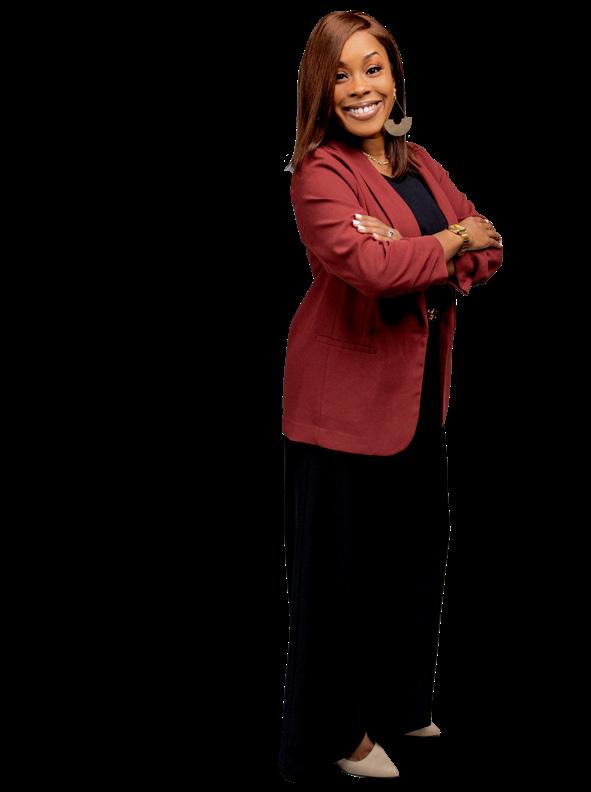
When Tasia launched Compassionate Connections in 2017, she was a one-woman show, but she currently has nearly 40 caregivers on sta .
In addition to providing all facets of home care, the agency will soon be o ering home healthcare with RNs, as well as non-medical transportation services.
Tasia also plans to franchise her company this year.
“I’ve been branding the business from the beginning to set us apart, and I look forward to having multiple Compassionate Connections in the state and then seeing it go nationwide,” says Tasia. She and her husband Marvin are the proud parents of daughters, Majesty, 7, and Royalty, 1.

In a world that insists on racing ahead, one family nurse practitioner realized there’s more to be gained by slowing down a bit.
At Anchored in Health, Amy Ester, FNP-C, knows her patients by name, understands their concerns and makes it her mission to find solutions that aren’t limited by standard treatments and therapies.
“I wanted to go back to how medicine used to be when you had a relationship with your provider. I felt like traditional health care was moving away from treating the patient and more about treating the disease process,” says Amy. “I really want the patient to know that they are heard and that we will work as a team to better their health.”
Patients who come to Anchored in Health are tired of being seen as a number. They want to be seen as an individual by a provider who’s eager to find the cause of their symptoms, not just write a prescription.
Born and raised in Central Florida, Amy enlisted as an X-ray technician in the United States Army and served for six years, during which she found her calling to become a nurse.
Amy earned her Master of Nursing, specializing in Family Nurse
Practitioner. She has since practiced in family medicine, urgent care, obstetrics, and gynecology.
Amy launched Anchored in Health in 2021 and has been in her current Oxford location since May 2023.
Her practice o ers membershipbased health care in a warm and welcoming atmosphere. Patients pay a flat fee per month based on their age range. This option is especially convenient for those who don’t have health insurance, have a high deductible, or just need a provider who is easier to see for routine visits.
Many women find it frustrating to find both a primary care provider and another provider for women’s health. Thanks to her background in women’s health, Amy handles both.
From wellness exams and general health to preventative care and well-woman exams, family planning, minor injuries, sports physicals, and more, Anchored in Health has become the provider of choice for many Central Florida residents.
The clinic also o ers vitamin infusions and weight management options for preventative care.

“I want my patients’ lasting impression to be that they’re seeing a trusted provider who cares, sees them as person—not a number-and will fight for their health,” says Amy.

352.203.3074
www.anchorednhealth.com
4060 Thomas St., Unit 4, Oxford
PAID PROMOTIONAL FEATURE “Be joyful in hope, patient in a iction, faithful in prayer.” - Romans 12:12With multiple locations in Central Florida, Lorven Heart and Vascular Institute, LLC o ers top quality care for cardiovascular conditions.
Jeveria Ali, DNP, APRN, has worked with Dr. Qamar since 2009. Her journey in health care has been fueled by great passion.

Raised in New York, Jeveria’s life plan was to become a physician like her mother, but she got married at a young age and started a family who became her priority. Jeveria has been happily married for 25 years now and is a mother of four, ranging in age from 5 to 22.
After graduating from SUNY with a degree in pre-med and English literature, Jeveria focused on her children, but never gave up her dream of a career in
In 2004, she and her husband relocated their family to Ocala where their extended family had already moved.
When her youngest child was 8, Jeveria was accepted to medical school, but realized it would require too much sacrifi ce by her family, so she chose to be a nurse
“I had to ask myself what was most important--initials after my name or going into health care to help people,” she recalls.
The fi rst day of class, she discovered she was pregnant with their fourth child.
The
“It was a long journey although I took an accelerated program. If it wasn’t for the support of my husband, parents, and family, I couldn’t have done it,” says Jeveria, 44, who graduated from UF in 2022.
She’d already been working in Dr. Qamar’s practice as an EKG tech, cardiac rhythm analyst, medical assistant, and cardiovascular technician, but needed nursing experience.
“I started working as an RN at West Marion Hospital right before Covid hit. Holding hands with people while they took their last breaths when their family members weren’t allowed in really humbles you. Working as a new nurse during those unprecedented times surrounded by so much tragedy made me realize how much this role meant to me,” she says.
Today, Jeveria routinely works with patients at Lorven Heart for follow-up after cardiac procedures.
“A lot of my time goes into educating patients,” she says. “It’s satisfying to provide patients the information they need to improve their quality of life.”

It’s a sad truth that most of us take better care of our vehicles than we do our bodies.
When people in Central Florida decide to take an active role in their health journey, they turn to Immunity Health in The Villages.
Whether it’s boosting their immune system to keep from getting sick, or just to be more wellness centered, this pioneering health clinic o ers a full menu of services.
Clients sense the di erence the minute they walk in. There’s a palpable feeling of care, kindness, and calm.
Leading the team of expert providers is owner Sabrina Ciceri, who opened Immunity Health in 2020.
“My passion is to inspire and educate people about the power they have to take accountability over their own health,” she says.
After working as a nurse in conventional medicine for 10 years, Sabrina set out on a mission to learn the REAL truth about health. She’s spent the last 20 years gaining wisdom in the area of preventative care and the reversal of diseases and premature aging, rather than treating symptoms.
“Our bodies are wonderfully made and know what to do. When people
give their bodies the nutrients and support they need, the body will heal in every way--mentally, spiritually and physically,” says Sabrina.
Over the last 15 years, she’s worked with people from all over the world whose doctors gave them dire prognoses and often just months to live, but the clients proved them wrong by using therapies and lifestyle changes that promote balance and healing.
Among the therapies offered at Immunity Health are:
• IV infusions
• Red light therapy
• Energy beds
• Hyperbaric oxygen treatment

positively at a cellular level.”
When the immune system is strengthened through preventative medicine, clients not only heal, they also look and feel their best.
Many clients come in for onetime treatments, but others prefer membership packages to take advantage of a combination of therapies that promote wellness and overall health.
“Any individual therapies benefit the body and slow down aging, but when you can layer these modalities, it magnifies the benefits of each therapy,” explains Sabrina. “When you bio-stack nutrients with oxygen, energy, and red light therapy, you are combining the most vital things to optimize your health. It’s called Biohacking and it changes your body
Not sure what therapies would be most beneficial for you?
Immunity Health o ers free consultations on health, sexual wellness, and skin analysis. Call today to book your consultation and begin your wellness journey.

833-4-TIME4U www.immunityhealth.com
Balance is crucial. When our bodies are out of balance and su ering from inflammation, it’s impossible to be healthy.
Gretta Ellis, APRN, learned this di cult lesson firsthand. Turning her own health around inspired her to help others.
Born in Leesburg and raised in Sumter County, Gretta grew up eating like many Southern families.
“I had major gut issues in my twenties because of inflammation. I knew there had to be an answer and a di erent option from mainstream medicine and just taking ‘band aid’ medication,” says Gretta.
“It wasn’t until I got really sick that my eyes were opened. I really think God let this happen and made it my purpose to help others,” she notes.
Gretta worked as an ER nurse, and in hospice, palliative care, and family medicine before opening Ellis Integrative Family Practice in Tavares.
“My heart and soul passion is fixing gut health and inflammation because everything starts in the gut. If you don’t have a healthy gut nothing will work right,” says Gretta. “Severe fatigue and joint issues can
often be remedied if you address gut inflammation.”
Although many people blame genetics, it’s often lifestyle and diet that cause their health issues.
Balancing hormones also plays a big role in overall health — for women and men.
Gretta uses bio-identical hormone replacement and measures her patients’ bloodwork to ensure the balance is right.
Whether it’s women struggling with sleep issues, night sweats, weight gain and mood problems, or men battling the loss of testosterone as they age, bioidentical hormones can make a night-and-day di erence.

testing, aesthetics, and natural approaches to autoimmune disease management, etc.
“These aren’t synthetic injections that can pump you up and down like a roller coaster. Bio-identical hormones are incapsulated to slowly dissolve over four months, so they keep you on an even plain,” Gretta explains. “They also help with bone density and brain fog, and act kind of like an anti-aging assistant.”
Patients come to Ellis Integrative for many reasons, including natural approaches to gut health issues, bio-identical hormone replacement, IV therapies, PRP regenerative therapies, food intolerance
Patients appreciate that Gretta looks at the big picture to discover any underlying health concerns and then helps them address the root causes, not just treat the symptoms.
If you’re ready to improve your overall health, call today for your appointment.

352.508.5418
gretta@ellisintegrative.com
1865 Nightingale Ln., Suite B, Tavares
The expert team at Lorven Heart and Vascular Institute, LLC specializes in interventional cardiology and cares for the whole vascular system.
Mary Lane, APRN, has been one of the providers since 2014.
PAID PROMOTIONAL FEATUREbecoming a nurse practitioner because she believes in having a collaborative relationship with patients.
She’s worked in family practice, urgent care, the ER, and an openheart unit, all of which provided a beneficial background for her practice today.

“I love helping people and doing what I can to help them live a healthier lifestyle and have a good quality of life,” says Mary.
“When I see patients, I don’t believe I should have my nose in the computer. I’ll make notes and finish them later. I want to make eye-to-eye contact with my patients and hear what they’re saying. I dedicate my time with patients to listening to them because they deserve it,” she says.
When problems arise, Mary takes the time to explain so patients understand how the disease process a ects them.
Sometimes a patient is reluctant to take medication or make changes. In that case, she’ll explain what can happen if the situation is ignored.
“With high blood pressure or
cholesterol, I’ll share ideas on how to address it with diet and exercise, and not just jump to medication,” she notes. “When patients want to make lifestyle changes, we’ll give them three months to implement the changes. Then they’ll come back, and we’ll check to see if this was successful, or if medication is needed,” says Mary.
If medication is necessary, she’ll fully explain what benefits the drug o ers and any potential side e ects.
“If I ever get to the point where patients are just a number, it’s time for me to retire. Every day I pray to be a good provider and ask the Lord to help me take care of my patients. I can’t do what I do without the Lord,” says Mary, who serves as pianist at her church.
Born and raised in St Pete, Mary has lived in Ocala since 1998. Married for 28 years, Mary and her husband have four daughters.
Mary has had horses and ridden since childhood, so Ocala’s equestrian atmosphere is a plus. When she’s not working, you’ll likely find her horseback on the scenic trails around Marion County.


Making your end-of-life healthcare wishes known is a win for everyone involved in your care. That’s why during National Healthcare Decisions Month, healthcare organizations across the country highlight the importance of having advance directives, with April 16 celebrated as National Healthcare Decisions Day.
This is a national program designed to inspire, educate and empower the public about the importance of advance care planning by completing your advance directives. Making your healthcare decisions a priority is important and what better time than during National Healthcare Decisions Month.
Advance directives are legal documents that include a living will or a durable power of attorney for healthcare, also known as a healthcare proxy. Either document allows you to give directions about your future medical care; think of it as a
road map for your family and doctors. It’s your right to accept or refuse prolonged medical care if you have a serious, sometimes terminal illness. Advance directives can protect this right if you ever become mentally or physically unable to choose or communicate your wishes due to an injury or illness. By law, the decision belongs to the patient –make your wishes known to your family, healthcare providers and caregivers; it can be changed or updated at any time.
An advance directive can be as simple as a two-page Living Will or as lengthy as the Five Wishes, a detailed user-friendly booklet. In Florida, an advance directive requires neither an attorney nor a notary, just the writer’s signature and that of two witnesses.
Just as preparing a will is optimal when we are of sound mind and body so is advance care planning. Talking with your loved ones about what you want
to happen should you not be able to speak for yourself and identifying who you want to speak for you is a gift that only you can provide. Having advance directives in place provide peace of mind and avoids burdening families, wondering what loved ones would have wanted during a medical emergency or crisis.
IN SUMMARY, ADVANCE DIRECTIVES CAN:
• Protect your rights to make your own medical choices, especially if you’re unable to communicate;
• Help families avoid the stress of making di cult decisions;
• Assist physicians and caregivers by providing guidelines for your care; and
• Limit life-prolonging measures when there’s little or no chance of recovery, if that’s your choice.
Advance directives are available to download at no charge at www.hospiceofmarion.org.
STORY: HOSPICE OF MARION COUNTY
When relationship experts talk about the challenges of having a healthy marriage, one thing comes up again and again: that it takes ingenuity and e ort to have a spouse who is everything you really need – a friend, emotional support, partner in running a household and a lover.
Sadly, most people decide to give up on one of those roles… and that is usually the lover. It appears that the things that make a good partner who supports their mate emotionally can also take the spice out of the romance.
Romance requires more tension — and even a little uncertainty — to create sexual chemistry, and those
often go away when “friendship” and “partnership” exist.
I believe that happens because di erent moments of the week require di erent attitudes. Couples need to set aside time for spice. It doesn’t just happen by accident.
Before I give you some tips, I must caution you: Know what you are doing before you try anything too new! Once my husband Joe and I had been married long enough to master friendship and
partnership, we began to be intentional about having great sex. (Yes, that’s what I was talking about when I said “spice”).
For instance, I read somewhere that new and fun sensations could be created if a man waxed his entire body. So I bought a wax pot, and, incredibly, Joe agreed to let me wax him.
Warning: What follows is graphic, rated PG-13.
I got Joe to lay up on the bathroom counter after I mixed up enough wax for 10 people. I didn’t really know what I was doing. I started with his privates and put on a strip of wax that was quite a bit more than I needed. Then… I ripped it o with visions of the pleasurable time I was expecting later that day. Well, those visions were replaced by a new vision that I still have trouble erasing from memory — Joe screaming on the bathroom floor where he had fallen. Once the blood was cleaned up, Joe was left with one strip of a clean-shaven area. In the end, I’m sure I rewarded him with some fun, but that was the last time we tried that.
Waxing didn’t turn out as well as I’d hoped, but the point is that married couples have to try new things. We were created with all kinds of needs, and, contrary to what some think, sexual intimacy is not just for making babies; it’s for enhancing happiness in a marriage, but the default will almost always be a loss of sexual desire, so keeping it spicy must be intentional.


Here are some things that you can do that (probably) won’t lead to screaming that’s what you’re into)
Plan for it.
Sexual attraction needs to be planned for. That’s a fact of reality and human nature. Imagine you both know that Tuesdays, Fridays and Sundays are sex days. From the time you wake up in the morning, the attitudes are di erent. On these days, his primary role is to be your lover; everything else is secondary. You’ll be thinking about it all day and it’ll pay o at night.
Work on physical fi tness.
Not only will you feel more attractive, but you will have better blood flow, which increases sexual sensitivity.

Read a book together about having better married sex.
Do something erotic at a time and place you wouldn’t normally think of being spicy.
In the kitchen you are usually just cooking and making school lunches. What if it was also a place where you made an advance? Usually those things only happen at night, but what if it happened at 10 in the morning? The odds of some bedroom fun just went up.
There are lots of great books about this, and even some great Christian books about having a healthy married sex life. Just make sure you’re both reading it, so you don’t get all hot and bothered when he just wants to go to sleep.
Try something different.
It can be daunting to try new positions or add some element like role play, but that is exactly why it works. The di erent and slightly scary creates a whole new mood and almost mimics some of the chemistry of first getting to know this person. The routine and normalcy is what takes away sexual tension, so creating some with an uncertain element will bring it back.
The most important thing is simply realizing and accepting that, unlike when you were dating, sexual attraction has to be cultivated when you are also best friends and life partners. There is nothing more natural than that, so go with it and have fun!
Sabrina is a self-confessed go-getter, and owner/ founder of ‘Immunity Health,’ an evolutionary wellness center in Lady Lake. As published author of “If It’s Not One Thing It’s a Mother”, and having lovingly fostered and adopted many children over the years, it’s no surprise Sabrina and husband Joe were named the 2014 Foster Parents of the Year by Kids Central Inc.


This is such a loaded debate, as I personally know, and have high regard for, very compassionate and accomplished medical practitioners of both sexes.
And while I have some instinctive and personal thoughts about how I feel as a patient being seen by male and female medical professionals, I first wanted to turn to some reliable sources.
Surely, there must be some data on this. And there is. One of the first things that caught my eye was a statistic from the American College of Cardiology (February, 2021): “Female physicians have better patient outcomes compared with their male peers, while female patients are less likely to receive guidelinerecommended care when treated by a male physician.” Is this luck, skill, a better understanding of a shared anatomy, or some
variation of a “Sisterhood of the Traveling Pacemaker?”
I can almost hear my male physician friends deleting me from their contacts right about now. And to be clear and fair, I’m sure there is research that would either discredit such findings, or at least provide a di erent context.
Afterall, you would intuitively assume that men relate better to male practitioners, and women to women. Certainly when it comes to sex-specific issues and conditions, right? Candidly, I feel much more comfortable with a female GYN seeing my wife or daughter. On the other hand, I might wrestle with a prostate conversation (let alone, an exam) with a female practitioner.
However, as I’ve aged, due to what I would generally describe as a better “connection,” I have found myself more comfortable with female practitioners. I do have
some fabulous male docs as well, but as I think about the ones I see with annual regularity, the majority are female, as are the surgeons who have performed procedures for me over the years.
I’m painting with really broad strokes here, but I think so much of this is driven by the personalities of both the patient and professional (including mid-levels, APRNs and NPs). Some are no-nonsense, to the point, no interest in sugarcoating. Others have deep compassion, empathy, and can read the room. I think there is absolutely a place for both in the profession. While the research and statistics are valuable, it begins with personal preference — Do you want a doctor who is going to rip the proverbial band-aid o , or one who is going to talk you through what you’re about to feel, answer your questions, and count it down?


My earliest memory of the doctor’s o ce is Dr. Raphael Cheas. I was devastated when I aged out of his care, and I have yet to find another doctor who called me “Princess” and told me I was “perfect.” (Can you blame me for not wanting to leave?) No matter what stage of life I was in, I always felt comfortable with Dr. Cheas and asking him questions. The fact that I was a female seeing a male practitioner didn’t even cross my mind.
As I’ve gotten older and I’ve started seeing more than just a primary doctor, my opinions have changed. When scheduling an appointment, I tend to look for female physicians when possible. I have come to feel, at this point in my life, female practitioners understand me better.
If you remember my side from our last debate, I mentioned that I ask a lot of questions. I’m a communications major at the University of Florida and I know very little about the human body. So when I go to appointments, I want to make sure that the time I spend with the
physician is productive for both of us. For me, this is achieved by asking questions.
From my previous experiences, I have found that female practitioners are more open to taking the time to answer questions and provide me with explanations that make sense to my lay-person’s brain. Oftentimes, female providers have had similar experiences to mine so they may communicate from a personal perspective. I’m not sure if that’s just luck, but it makes me feel valued and heard.
I recently had a negative experience at a doctor’s o ce. I was a new patient and during my explanation of why I was there and what I was experiencing, it was clear to me that the practitioner had decided the course of action before even walking into the exam room. All questions were directed to the medical assistant, and they were in and out
in less than 10 minutes. I was frustrated and felt like what I was experiencing was ignored.
Now, this is not to say that all of this happened only because the physician was male. I’ve had a similar experience with a female provider too. But if this provider had been female, I think I would have felt more comfortable asking questions to ensure that the appointment wasn’t a waste of time and money.
We can’t all have a Dr. Cheas (sad, I know), but no matter what, we should all feel comfortable with, and confident in, our providers’ abilities to give us the care we need.


Finding a doctor, you love is a crucial aspect of maintaining optimal health and well-being. At The Villages Health, our unwavering commitment to providing exceptional healthcare has cultivated a community of loyal patients who appreciate our value sta , state-of-the-art facilities, and unique care model. Over the years, we have consistently received recognition in the “World-Class” category based on real patient feedback data, a testament to the quality of care and patient satisfaction we consistently deliver.
Our healthcare approach surpasses the conventional, emphasizing the establishment of strong patient-doctor relationships. Our clinicians take the time to understand each patient’s individual needs, ensuring a personalized and comprehensive care experience. The collaboration between our primary care and specialty care divisions further enhances our ability to provide topnotch healthcare services. This commitment extends not only to maintaining your overall health but also to facilitating a speedy recovery if the need arises.
For those who are already part of The Villages Health community, we invite you to share your positive experiences with your friends and
family. Your recommendations can play a crucial role in helping others make informed decisions about their healthcare. With the Open Enrollment Period concluding in March, now is a pivotal time to consider your healthcare choices for the current year.
At The Villages Health, continuity of care is a top concern, and we want to ensure every patient’s ability to access the exceptional healthcare they deserve. Whether you are a new patient seeking a compassionate physician you can trust, or an established patient managing insurance changes, our dedicated support team is here to assist you. We believe fi nding a doctor who sees you as a whole person is fundamental to building a satisfying doctor-patient relationship. Your health journey should begin with a partner you can rely on, and The Villages Health is committed to being your advocate for wellness from day one. Our personalized approach, coordinated care teams, and New Patient Specialists provide comprehensive support - from navigating complex insurance choices to building lasting patient-doctor relationships. Your health and well-being are our top priority.
We understand that navigating insurance options can be complex, and our goal is to make this process as seamless as possible

for our patients. If you are considering changing plans or have recently done so, our New Patient Specialist can provide valuable insights and assistance. They are well-versed in the intricacies of insurance plans and can help you make informed decisions that align with your healthcare needs.
For new patients, the process of selecting healthcare providers and insurance can feel overwhelming, but at The Villages Health, we make this process as stress-free as possible. Our New Patient Specialists and our licensed benefi ts consultants are experts in the fi eld, equipped to guide you stepby-step so that you can make the healthcare and insurance decisions that fi t your needs perfectly. We encourage you to meet with our specialists, who will listen carefully to understand your unique situation, explain all your options in simple terms, and provide recommendations tailored specifi cally for you. With their assistance, you can look forward to fi nding healthcare solutions that not only check all the boxes but give you the confi dence that comes with choosing providers who see you as a valued partner in your health journey.
For existing patients who have recently adjusted their insurance plans, we recommend checking with our New Patient Specialist team to confi rm continued eligibility for care at The Villages Health. Changes in insurance plans can sometimes result in unforeseen limitations, such as no longer being able to see your current doctor under the new plan. To avoid any disruptions in
your healthcare, call us or visit our care centers. We are ready to guide you through the decisionmaking process.
At The Villages Health, we prioritize continuity of care and want to ensure that every patient can access the healthcare they need and deserve.
Discovering exceptional healthcare is not just about fi nding a provider; it’s about forging a lasting partnership dedicated to your well-being. At The Villages Health, we prioritize this relationship aspect of healthcare, understanding that trust and communication are essential foundations for optimal health outcomes. Our care teams are not only skilled professionals but also compassionate individuals who genuinely care about your health journey. From your initial appointment to follow-up visits,

we strive to ensure that you feel heard, understood, and supported every step of the way.
Moreover, our commitment to exceptional healthcare extends beyond the walls of our clinics. We actively engage with our community, o ering educational seminars, wellness programs, and health screenings to empower individuals to take control of their health. By fostering a culture of health and wellness, we aim to not only treat illness but also prevent it, promoting longevity and vitality among our patients. At The Villages Health, we believe that true healthcare encompasses not just the absence of disease, but the presence of holistic well-being in mind, body, and spirit.
To discover more, call us at 352-320-5877 or visit thevillageshealth.com/exceptional



Dr. Aurindom Narayan takes pride in providing comprehensive care and guidance to patients in Summerfield and surrounding communities.PAID PROMOTIONAL FEATURE
For more than two decades, Dr. Aurindom Narayan has been at the forefront of the field of internal medicine, leaving a lasting impact on his patients and the healthcare community.
His journey into the world of medicine began in New Delhi, India, where he pursued his medical education at the All India Institute of Medical Sciences. Initially, he qualified as a general surgeon, but his career path took a turn when he couldn’t secure a job in India and struggled to obtain a categorical residency in the United States.
Driven by a passion for healthcare, Dr. Narayan switched to internal medicine, his second love. He completed his residency training at the University of Medicine and Dentistry of New Jersey and since established a reputation as a dedicated and respected Internal Medicine Specialist in a wide range of settings from hospitals and nursing facilities to rehabilitation centers and assisted living communities.
After moving to Florida, Dr. Narayan practiced in St. Petersburg and is now settled near Summerfield where his o ce at Lakeview Healthcare System—a partner with Aegis—is located today.
There, Dr. Narayan takes pride in addressing his patients’ health concerns from head to toe, including standard o ce visits and treating illnesses to minor procedures like skin surgery, and joint injections. His patient-centered approach places a strong emphasis on preventive care to optimize health and longevity by working to prevent problems before they arise.
Dr. Narayan’s commitment to comprehensive patient care is supported by his belief in a multidisciplinary approach to medicine. He values teamwork and strives for the best possible outcomes for his patients. As he puts it, “I like to be involved in the care of my patient as a whole and not just be a referrals coordinator sending patients to di erent specialists for every problem.”
Recognizing his limitations, however, when he does end up referring a patient out, Dr. Narayan says he makes sure to stay in the loop.
“Let’s say my patient has a complex cardiac problem and I send my patient to the cardiologist,” he explains. “Well, I’m not just washing my hands of it. I would want to know what the cardiologist recommended, why he recommended it, and whether my patient is happy with that recommendation. In the process, I learn something, my patient learns something, and together we grow and move in the best possible direction.”
If interested in seeing Dr. Narayan, he is currently accepting new patients. To schedule an appointment, contact his o ce at 352.307.9925.


We can’t blame our parents for all our issues, but the foundation for relationship skills in adulthood does develop when we are young.
Psychoanalyst John Bowlby believed that attachment styles formed in early childhood influence our behavior and mental health as adults. Bowlby’s research was
conducted in the 1950s, but mental health experts still widely use his theory on attachment patterns.
“Bowlby’s theory remains a foundational concept in psychology, especially in developmental and clinical settings. Over the decades, there have been refinements and extensions to his work, but the

core principles remain widely respected,” says W. Steven Saunders, Psy.D., a licensed psychologist at Central Florida Psychology in Clermont.
Research revealed four basic categories of how infants reacted when separated from their parents and how these behavior patterns translate to adult relationship skills.

Secure: Although initially distressed upon separation, the child was easily comforted upon the parent's return. As adults, they tend to have good self-esteem, the ability to share feelings and form lasting, trusting relationships.
Anxious-Resistant: The child experienced a high level of distress followed by seeking comfort by staying close to the parent. As adults, they tend to lack selfconfidence, isolate socially and have exaggerated emotional reactions.
Anxious-Avoidant: The child is distressed upon separation and withdraws and doesn’t seem comforted by the parent's return. As adults, they tend to be unwilling or unable to share feelings, have di culty forming satisfying relationships, may show aggression and antisocial behavior and they create distance to avoid emotional stress.
Disorganized-Disoriented: The child has no predictable pattern of attachment behavior when separated from the parent. As adults, they may view people more as threats than potential support, fluctuating between social withdrawal and defensive aggression.
SECURE ATTACHMENT
50-60%
ANXIOUS-RESISTANT ATTACHMENT
20%
ANXIOUS-AVOIDANT ATTACHMENT
20%
5-10%
DISORGANIZED-DISORIENTED ATTACHMENT: MANY FACTORS CAN DIRECTLY AFFECT THE STYLE OF ATTACHMENT
A CHILD FORMS EARLY IN LIFE. KEY FACTORS INCLUDE:
“Basically, if a child feels consistently safe, seen and soothed, they’re more likely to develop a secure attachment,” Dr. Saunders says.
We’ve all heard the stories of children raised in unstable homes who rise above the odds to become secure, successful adults despite their early years.
Even if the emotional environment at home isn’t healthy, other adults in a child’s life can provide a healthy emotional influence.
“Grandparents, teachers, coaches and other caregivers or mentors can play significant roles,” says Dr. Saunders. “Any adult who has regular and significant interaction with a child can influence their attachment style and relationship skills.”
When we don’t start out with a secure attachment style, as adults, we can change the way we relate and form healthier relationships.
“Self-awareness is key. Understanding your attachment style can lead to recognizing patterns in relationships. From there, therapy or counseling can o er tools to build healthier relationship habits,” Dr. Saunders says. “Also, choosing partners or friends who have a secure attachment style can promote personal growth in this area.”
Don’t fall for the excuse, “that’s just how I am.”
"While our past shapes us, it doesn't define us,” Dr. Saunders says. “With insight and e ort, change is within reach. Don't limit yourself to past patterns."
“Unlike height or eye color, attachment styles are not set in stone,” the doctor adds. “While our early experiences lay a foundation, with e ort and often with professional guidance, we can shift towards a more secure attachment style. It might require work, but change is definitely possible.”
Research into attachment styles has been underway for decades but the topic is hardly common knowledge.
“I had no idea there was such a thing as attachment styles,” says Style photographer Nicole Hamel, 39.
After coming out of an unhealthy 12-year marriage, she experienced relationships that were emotional roller coasters.
During the pandemic lockdown, Nicole began researching why.
She learned about attachment styles by reading “Attached: The New Science of Adult Attachment and How It Can Help You Find - and Keep - Love” by Amir Levine and Rachel Heller.
“Everything made perfect sense,” Nicole says. “I realized I had an anxious attachment and seemed attracted to people with an avoidant attachment style.”
Her parents divorced when she was 6 and both parents remarried. Her stepfather molested her when she was 9, and then threatened her to not
tell anyone or something bad would happen to her family. She was too afraid to tell her mother or father for two years. He was later charged with a simple assault charge and a restraining order was in place.
“They didn’t get me counseling because they thought if we didn’t talk about it, I’d forget about it. At times I did,” she recalls, noting that this deeply impacted her life. “Back then, no one really talked about feelings, and I was too uncomfortable to do so.”
In January of 2022, Nicole met someone completely di erent from anyone she’d dated before. Over the course of a year, he proved that his words matched his actions.
Nicole started counseling in July 2023. Therapy, along with her earlier research, has been a game changer.
“I got it wrong for so many years, this time I want to do it right,” says Nicole, who is relieved to have left the emotional rollercoaster behind. “I decided to take the next step by going to counseling and finally starting to work through my own childhood traumas and continue to heal myself so that I am more present in my healthy secure relationship.”
If you find yourself repeating old mistakes and past patterns, it may be time to seek professional help.
“If these feelings become overwhelming or persistent, professional intervention can be very beneficial,” Dr. Saunders says. “When attachment-related issues start impacting daily life, relationships or mental well-being, it’s time to consider seeking help.”
CYNTHIA MCFARLAND“I fell in love with words early on and knew from fourth grade that I wanted to be a writer,” says Cynthia McFarland. A full-time freelancer since 1993 and the author of nine non-fiction books, her writing has earned regional and national awards. Cynthia lives on a small farm north of Ocala; her kids have fur and four legs.












n the vast landscape of social media trends where memes flourish and hashtags reign supreme emerges a peculiar and lighthearted phenomenon: "Girl Math."
But what exactly is “Girl Math?” It's not a complex equation or a scientific breakthrough; instead, it's a whimsical way of looking at everyday calculations that take place in the minds of many women.
Picture this: You're at a restaurant with your friends, splitting the bill after a delightful
meal. In the realm of "Girl Math," the calculation isn't just about dividing the total by the number of people; it's a nuanced process involving factors like who ordered the extra guacamole, who only had a salad and who conveniently forgot to mention they were on a budget this week. The result? A carefully curated breakdown that goes beyond mere arithmetic.
One classic example of "Girl Math" in action is the wardrobe dilemma. Ever wondered how a woman can claim to have nothing to wear while standing in front of
a closet bursting at the seams?
That's "Girl Math" at its finest. It involves intricate algorithms considering outfit repetition, the need for new ensembles and the strategic planning of when certain outfits were last worn.
The equation may look like this: (Number of events in the next month) + (Outfit popularity index) –(Outfits worn in the last two weeks) = "I have nothing to wear!"
The trend has gained significant momentum on TikTok, with users creating hilarious videos showcasing their personal
The Friend's Birthday Formula:
(Strength of friendship) + (Budget constraints) - (Current social engagements) = Appropriate gift expenditure.

The Online Shopping Algorithm:
(Number of items in cart) + (Discount percentage) x (Shipping cost) = Final decision on whether to checkout.
(Number of attended sessions) ÷ (Monthly fee) x (Guilt level) = Cost per workout justification.
(Item cost) x (Return policy duration) - (Return shipping fee) = Net amount "earned" by successfully returning an item just in time.
(Amount of cash spent) + (Inconvenience of using an ATM) x (Perceived value of physical money) = Illusion that cash spending doesn't count as dipping into the bank account.
(Number of sale items purchased) x (Discount percentage) + (Excitement level) - (Actual budget) = Justification for overspending on sale items.
encounters with "Girl Math."
Whether it's calculating the exact amount of time needed to reply to a text to avoid seeming too eager or estimating the number of likes needed for a post to be considered viral, these TikTokers have turned everyday scenarios into comical mathematical puzzles.
However, it's crucial to acknowledge that the landscape of
"Girl Math" is as dynamic as TikTok trends themselves. The scenarios and equations that dominate the platform today may undergo a rapid transformation tomorrow. The sometimes short-lived nature of social media trends, influenced by the ever-changing dynamics of pop culture and the internet, ensure that what's trending one moment might be old news the next.
So, as we chuckle at the clever calculations of "Girl Math" on TikTok today, let's savor the humor knowing that tomorrow might bring a fresh wave of equations, each more amusing and perplexing than the last. After all, in the everspinning carousel of Internet trends, the only constant is change.
DO YOU HAVE A GREAT FINANCIAL ARTICLE IDEA? ROXANNE@AKERSMEDIAGROUP.COM
We’re all ears! Having healthy finances is crucial for a well-balanced life, and that’s why we believe in making finance one of our core pillars. Share your thoughts by emailing our managing editor, Roxanne@akersmediagroup.com. Let’s create something amazing together!

Maintaining a healthy lifestyle can be challenging in today’s fast-paced world. Most of us are too busy to cook and often end up turning to processed and unhealthy foods for convenience.

And that can get expensive.
A balanced diet, on the other hand, is crucial for our overall well being. But eating healthy doesn't have to be expensive.
With some smart choices, you can nourish your body without breaking the bank.
Before diving into tips for eating healthy on a budget, it's essential to understand your nutritional needs. The recommended daily calorie intake varies based on factors such as age, sex and your level of physical activity.
It's also crucial to have a balanced diet with a variety of foods including fruits, vegetables, whole grains, lean proteins and healthy fats.
1. PLAN YOUR MEALS: Start by planning your meals for the week. Planning helps you avoid impulse purchases and ensures you only buy what you need.
2. BUY IN BULK: Buying in bulk can often be cheaper in the long run. Look for nonperishable items like grains and beans.
Eating healthily on a budget may seem challenging, but with a bit of planning and smart choices, it's entirely achievable. Remember that investing in your health now can save you money on healthcare in the long run. Implementing these strategies may not only benefit your health and
3. CHOOSE SEASONAL PRODUCE: Seasonal fruits and vegetables are usually cheaper and fresher. Farmers markets can be great places to find affordable seasonal produce.
4. PREPARE HOME-COOKED MEALS: Preparing meals at home is healthier, allows you to control ingredients and portions and is typically cheaper than eating out or buying pre-packaged meals.
5. LIMIT PROCESSED FOODS: Processed foods might seem cheaper upfront, but they offer less nutritional value. Opting for whole foods can keep you satiated longer and reduce the need to snack frequently, saving you money overall.
wellbeing but also your finances. Keep trying di erent methods and find out what works best for you. Remember, the goal is not perfection but progress. Start small, and over time, these changes can make a significant impact on your life.
DO YOU HAVE A GREAT FINANCIAL ARTICLE IDEA? ROXANNE@AKERSMEDIAGROUP.COM
We’re all ears! Having healthy finances is crucial for a well-balanced life, and that’s why we believe in making it one of our core pillars. Share your thoughts by emailing our managing editor, Roxanne@akersmediagroup.com.
Let’s create something amazing together!

In the heart of Lady Lake, Florida, Chandler Wealth Management stands as a beacon of fi nancial health.

crafting a holistic approach to fi nancial well-being.

“We’re like fi nancial doctors,” says Craig Chandler, the company’s founder, emphasizing the analogy between physical and fi nancial health. Just as neglecting one’s health can lead to breakdowns, so too can a lack of attention to fi nancial strategies.
Chandler Wealth Management takes a proactive stance, urging clients to seek regular fi nancial check-ups. “It’s more than just managing your money; it’s about ensuring your lifestyle, securing your legacy,” Craig says.
What sets them apart? Holistic planning. Chandler Wealth Management collaborates with attorneys, CPAs, and other professionals, ensuring comprehensive coverage for clients’ fi nancial and estate needs. It’s not solely about managing money; it’s about building relationships, understanding clients’ lifestyles, and supporting their unique needs.
From retirement planning to legacy strategies, they cater
to diverse fi nancial needs. Snowbirds or locals, the fi rm o ers digital accessibility and multiple o ce locations across Florida and Georgia.
However, the standout aspect remains their commitment to the client’s best interests.
“As fi duciaries, our clients come fi rst,” Craig adds, highlighting their ethical obligation to prioritize clients’ needs over their gains.
With an emphasis on teamwork and long-term relationships, Chandler Wealth Management assures clients that they’re more than just fi nancial advisors; they’re partners in securing their fi nancial health and futures.
“It’s about making a di erence in people’s lives, even in small ways, and reducing the stress associated with fi nancial uncertainties,” Craig concludes.
In a world where fi nancial well-being is often overlooked, Chandler Wealth Management aims to be the guiding light, o ering not just fi nancial advice but a holistic approach to a healthier fi nancial life.

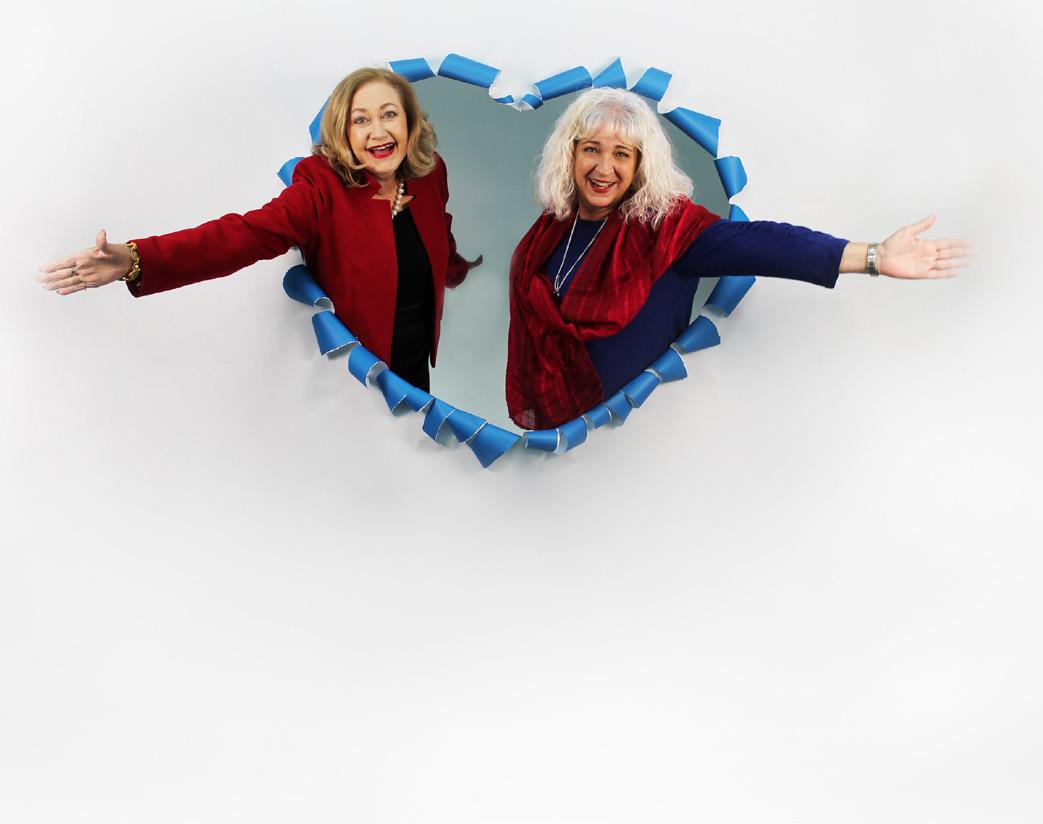
Approaching 65? Retiring and losing group insurance? Let us be your advocate!
Attend one of our information-packed seminars where our caring team will help answer your questions and provide a smooth transition into your new coverage. We are here to provide easyto-understand, accurate information to help you navigate your options and Make Medicare Easy!













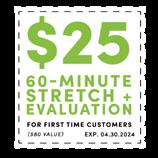

Since 1983, Hospice of Marion County has provided abundant compassion and expert care along with the power of choice and a promise that, "You are not alone."
HMC is an affiliate member of Empath Health, a nonprofit, integrated network of care serving more than 26,000 individuals in hospice care, home health, elder care and more. We are ready to serve the community whenever you need us.

"HER MOUTH IS FULL OF WISDOM; KINDLY TEACHING IS ON HER TONGUE."








